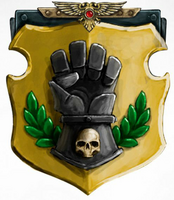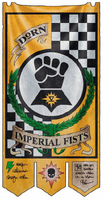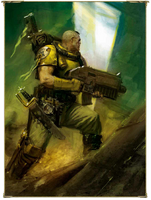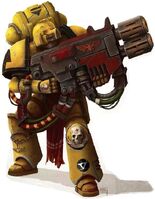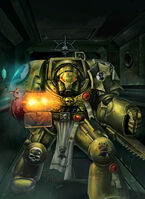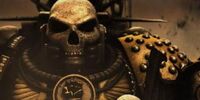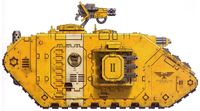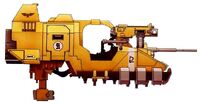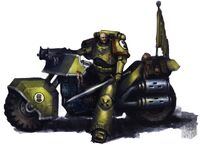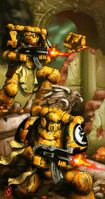"For others, the Great Crusade ended long ago. For us, it will not cease until all the worlds of Mankind are united once more and the Emperor's golden age returns."
The Imperial Fists are one of the First Founding Chapters of the Space Marines and were originally the VII Legion of Legiones Astartes raised by the Emperor Himself from across Terra during the Unification Wars. Loyalty in time of betrayal was not easy to measure, for one cannot look at the face of an ally and know if he is a friend or an enemy. Even after Horus' treachery screamed forth upon the death plains of Istvaan III and the Drop Site Massacre of Istvaan V, the truth of who was traitor and who remained loyal was far from clear. In this age of betrayal, one Legion stood as a pillar of loyalty amongst the sea of doubt. The Imperial Fists and their Primarch Rogal Dorn, ever true, never swerving from the toll demanded by a war of brothers, bore the weight of loyalty without breaking, but not without cost. Sacrifice without limit changed those who survived. Only now, would so much lost and so much more remade, could the Imperium see that the Imperial Fists who played their part in the Imperium's foundations, died with the Great Crusade.
The Imperial Fists are one of the most valiant of all Chapters, held as paragons of the principles set down in the Codex Astartes and exemplars of everything to which a Space Marine is heir. The Imperial Fists stand as the steadfast defenders of the Imperium and the Emperor's unwavering shield; for ten thousand years they have been the bulwark against which the armies of traitors and aliens have shattered. When Rogal Dorn was lost to the Imperium in the years following the Horus Heresy, his legacy remains amongst the strongest of all of the Primarchs'. Dorn's final moments were of courage and supreme sacrifice, and this example still drives the Imperial Fists onwards to fresh victories. Indeed, if the Imperial Fists have a fault, it is that they continue to strive when others would yield or withdraw. Such unquestioning steadfastness has rescued many a victory from the ashes of defeat, but only at a steep cost in lives.
The Imperial Fists stand out from other Space Marine Chapters since they possess no fixed homeworld, although they are most frequently based on Terra. Instead, the Imperial Fists rely on their 10,000-year-old mobile space fortress, Phalanx, to serve as their fortress-monastery. They maintain recruitment-chapels on various worlds spread throughout the Imperium. Part of the Imperial Fists' duties during the Great Crusade were to function as the Emperor's "personal praetorians", accompanying Him everywhere. The Imperial Fists were usually used to strike a decisive blow against the enemies He confronted during that time. The role of the Emperor's bodyguards since he was mortally wounded during the Horus Heresy and interred within the Golden Throne at the heart of the Imperial Palace on Terra has been entirely taken over by the Adeptus Custodes.
Chapter History
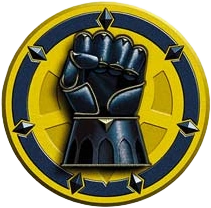
Badge of the Imperial Fists Chapter
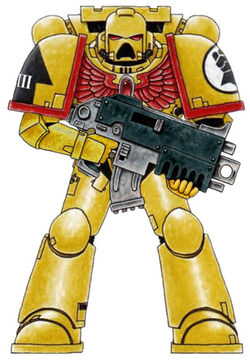
Imperial Fists Chapter Colour Scheme

Pre-Heresy Imperial Fists Colour Scheme

Unification Wars-era VII Legion Colour Scheme
Wars of Unification
If the Emperor was the father of the Legiones Astares, then Terra was their mother. Just as the Emperor shaped his warriors with his will and intellect, so too did Terra leave her mark on the warriors with His will and intellect, so too did Terra leave her mark on the warriors raise from her soil. These marks, or scars it might be more accurate to say, often shaped a Legion's culture, values and methods of war in ways as subtle and deep as the mysteries woven into their flesh. To understand how may of the Legions became as they were, one must first understand Terra. Soaked in blood, ignorance and atrocity, Ancient Terra in the time before the rise of the Emperor was devoid of hope and existed in a state of darkness. The only order was that of tyrants: fleeting and tainted by madness and petty ambition. The Emperor changed that -- first with his hosts forged from the techno-barbarian tribes, then with his army of gene-forged Thunder Warriors, then with the creation of the Legiones Astartes. With blood and fire he tamed Terra, bringing order and enlightenment where before there had been none. It was this transformation that the VII Legion was made to protect.
The first battalions of the VII Legion were raised from across Terra as shown by their earliest battle honour, "Roma". While many other Legions drew their recruits from a particular source, the flesh of the VII Legion came from Terra as a whole. Even in domains where other Legions had "Rights of Tithe", the VII Legion took some of the youths as initiates. Often these would be those who exhibited the greatest capacity for endurance, both in mind and body. Many were of a taciturn nature, slow to talk but quick to act. Why so many of such a wide pool of recruits should be similar is unclear. Certainly, the processes used to activate the VII Legion's gene-seed seem to have inflicted intense pain, and so perhaps it was a purposeful selection of stock suited to surviving the process. It is also possible that a pattern of recruitment once formed, perpetuated until it was tradition. No matter the reason, the grim nature of those recruited into the VII Legion was well suited to their use.
In war the VII Legion was concerned with conquest. While all of the Emperor's forces fought and died to expand the Imperium, many saw only part of the greater vision. Defeat the enemy, tear down his strongholds, break his beliefs and still you would have a land that could turn against the Imperium in the future, or provide other enemies with a weakness to strike at. Victory was not enough, to conquer one had not only to defeat one's enemies, but to hold the fruits of that victory. This philosophy underpinnned every action of the VII Legion. In attack they would pay any price in their own blood to secure victory, and once they had victory they would begin to consolidate what they had taken. This pattern can be seen time and again in the later conquest of Ancient Terra. It was the VII Legion which broke the Cities of the Crystal Sea, and then raised the Fortress of the Fifth Circle from their ruins. In the ice-wrapped pinnacles of Himalazia they lost three battalions to secure the defeat of the witchery of the Wind Caller clans, but the first Imperial bastions began to rise against the cold sky within days of that victory. Across Terra the fruits of their fortress-craft gazed down on those who dwelt in the land around, a constant sign that the strength which had conquered them remained, rooted into the earth.
In the first decade of their existence, the Imperial Fists raised six hundred citadels upon the lands of the conquered. It is said that the dead of the Legion lie still in the foundations of each, their skulls and blood mingling with the stone and mortar of their walls. With these bastions pinning the conquered lands to the Imperium, order would spread amongst the people of these new domains. The old ways would change, fall or be replaced by the new, and if they did not then the looming fortress would answer the question of what the response to rebellion would be. The VII Legion were more than builders and castellans. As their root they were the most direct expression of the Emperor's design of uniting humanity, they were crusaders. Fortresses solidified conquest, and the VII Legion sought conquest with a focused hunger. While fortresses and ordered domains sprang up in their wake, the VII Legion would never linger, but were always moving on, invading uncompliant domains and pushing the frontiers even as they reinforced what they had just taken. Massed shock assaults, using the full array of weaponry within the Legion, typified the VII Legion approach to war. Multiple battalions often took to the field enmasse, breaking enemies with hammer blow force. On the plains of Kennestar, the 5th Battalion of the VII Legion broke the lines of the Tyrancy with an arrowhead of fifty war machines. It is said that the dust cloud thrown up in their wake blotted out the sun. In the tunnels of Galabaz, they cracked the crust above the buried city and dropped into the exposed tunnels beneath while the explosions were still echoing across the mountains. But always, in the wake of the destruction they wrought, they replaced what they had broken with something stronger.
It was from these early conquests that the VII Legion acquired its name. When many looked on the lands taken by the VII Legion, they said that it was as if, "the hand of the Emperor had descended and gripped with an unbreakable fist". The description of the service done by the VII Legion must have pleased the Emperor for he personally decreed that they would be known from then on as the Imperial Fists and bestowed on them the right to bear the Laurels of Victory as part of their heraldry. Dutiful and taciturn as ever, it is said that the renamed Imperial Fists accepted their honours in humble silence.
Rogal Dorn
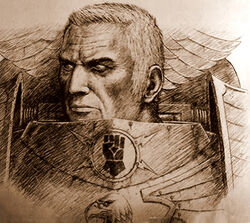
The Imperial Fists Legion Primarch Rogal Dorn
Primarchs are transcendent beings, holding a portion of the sublime and unknowable in their nature. All the qualities which seem strong in a warrior of a Legion exist more strongly, more deeply and with greater subtlety in a Primarch. Though spun from the seed of humanity the Primarchs are not human. This nature often seems to enhance and focus the qualities gifted to a Legion by their gene-seed. So it is that at the moment at which Primarch and Legion unite, there is often a point at which a Legion's character may seem to shift. In the case of the Imperial Fists, the discovery of their Primarch, and the planet which had raise him, only strengthened the character the Imperial Fists had shown since their creation. When the the 20 genetically-engineered nascent Primarchs were stolen from the Emperor's labs on Terra by the Ruinous Powers and cast into the Warp, they were scattered throughout the galaxy upon different worlds, which would come to shape the nature of each Primarch and later their individual Legions created from their genome. When the Primarch Rogal Dorn was restored to the Imperium, it was to be on the Ice World of Inwit located in the Inwit Cluster.
Inwit: Darkness and Ice
Inwit was, and is, a world of death and cold. Its star is old and withered, bleeding the last of its heat as cold, red light. Tidally locked against its dying star, perpetual darkness soaks one side of the planet, faded sunlight the other. Crevasse mazes, frozen mountain ranges and plains of frost dunes cover the planet's dark side -- this is the Splintered Land, the beast-stalked wilderness which shapes the bodies and beliefs of the human population that clings to life here. Under the ice crust, thick seas flow in sluggish tides and pale and sightless creatures swim the waters, hunting by vibration and a preternatural taste for blood. Far above this desolation, great and ancient space stations and shipyards look down on the cold-shrouded worlds through perpetual auroras -- created in a lost past, these citadels of the void have looked down on Inwit since before any records or tales can recall. Whilst on the planet, the light side of Inwit offers little more comfort than the dark, being a land of drift-crusted saline seas and sparse bare rock under the unblinking gaze of the red sun.
There is little of value on Inwit; its seas are buried or lifeless, its mountain bare of riches and its native species vicious. There is, however, one that thing that this harsh world produces that led it to conquer a star cluster and endure as an island empire of order in the Age of Strife: its people. Though they are barbaric, they are far from unsophisticated. The warriors of Inwit are raised to endure and survive. The world that bears them teaches them to never relent and that the price of weakness is death, for them and the rest of their kin. Death comes in many forms on Inwit in the ice storms that can freeze and cover a man in seconds, at the claws of the predators that roam the Splintered Lands, and in the lapse in concentration that allows the cold to penetrate the warmth-seals of a hold. These factors make a certain kind of people: strong, grim and dedicated to the survival of the whole rather than the individual. Much of the population is nomadic, moving between the subterranean ice hives to trade in weapons, fuel and technology. Conflict between the roaming clans is common and young warriors lean how to defend against their clan's enemies as early as they learn how to endure the death touch of Inwit's merciless chill. They know how to learn, have an innate sense of an object's functional value and, most importantly, they have the strength to conquer those who possess knowledge they do not.
Long ago, before the coming of the Emperor was even a dream on night-shrouded Terra, the people of Inwit began to create their own realm in the stars. On every world they took, they assimilated, realigned and reinforced. With each conquest their culture and learning grew, but Inwit itself remained unchanged even as it became the centre of an empire. The ice hives and clan disputes remained and while their world birthed star ships and ringed its orbits with weapon stations, its rulers kept to the old ways, the ways that had created their strength, the warlords and matriarchs who commanded armies amongst the stars still living lives little easier than their vassals. So it was, and so it is now.
It was a part of this burgeoning empire that Rogal Dorn grew to manhood, and then to rule its domains as emperor. Much of his early years remains unknown, or at least little talked about. What is known is that from the cold and darkness of Inwit the boy, named Rogal by his adoped kin, rose to lead the House of Dorn or the Ice Caste and then to the rule of the Inwit Cluster. The patriarch of the clan that raised Dorn became an adoptive grandfather to him, and taught him much of tactics, strategy, and diplomacy. Even after he discovered he was not blood-related to his "grandfather," Dorn held his memory in high value; he kept a fur-edged robe that had belonged to the man and slept with it on his bed every night. His qualities married perfectly with those of Inwit, and he pushed their empire further than any other, ordered and trained its armies, and fashioned space craft the like of which had not been seen before.
The Coming of the Emperor
"Do not look to us for kindness. Do not look to us for hope. We are not the kind children of this new age. We are the rocks of its foundation. If you wish hope then look to what we make. If you wish kindness then look to those who will come after us."
- — Rogal Dorn, address to the Three Hundred Magistrates of Terra
Forty standard years after his grandfather's death, the outlying Imperial starships of the Great Crusade finally reached the Ice Hives of Inwit. When the true Emperor was reunited with Rogal Dorn, He regained not only a lost son, but the strength of a star spanning society already forged into a tool of war. Dorn greeted the Emperor at the helm of the enormous starship constructed during the Dark Age of Technology called the Phalanx that he had discovered within Inwit's region of space. Dorn became the seventh of the twenty Primarchs who had been found by their father. The Emperor welcomed Dorn as his long-lost son, and returned the Phalanx to his care, transforming it into the mobile fortress-monastery of the VII Space Marine Legion that was also turned over by the Emperor to Dorn to lead, since all of its Astartes had been created using Dorn's own genetic template.
Dorn himself was fiercely loyal to the Emperor from the first moment that they met on the bridge of the Phalanx, and he never once sought any favour from his father. Dorn embodied the human quest for truth, and could never tell a lie, even if it would have aided his cause. Because of this quality, Dorn's statue stands as one of only four ever erected on Macragge, next to that of Roboute Guilliman, Primarch of the Ultramarines. Dorn commanded the VII Legion and Expeditionary Fleets with peerless devotion and military genius. It was said that he possessed one of the finest military minds amongst the Primarchs, ordered and disciplined but still inclined to flashes of zeal and inspiration. His record of achievements for the Imperium during the Great Crusade were innumerable, and indeed the Warmaster Horus thought of the esteemed Dorn and the Imperial Fists so highly that he reckoned if the Fists, noted masters of defence, were to hold a fortress against he and his Luna Wolves, noted masters of assault, the resultant conflict would spiral into a never-ending stalemate.
Great Crusade
Illumination's Crusaders
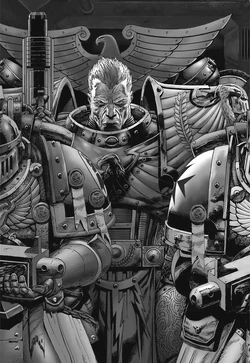
Primarch Rogal Dorn with First Captain Sigismund and other senior Imperial Fists Legionaries
Dorn was possessed of a single-minded energy tempered by a reserved and stoic nature. Many have remarked on the dour and emotionless disposition of both Primarch and Legion, but such an assessment misses much. Reserved, but terrifying in anger, Dorn was both cautious and calculating, and capable of pursuing an end with relentless energy. While he would rarely show emotion, when he did it was capable of shaking the ground or darkening the sun. During the near disastrous resurgence of the Xahelican breed in the Adonis Cluster, Dorn's cold rage was said to have held the battlements as much as the arms of those standing upon them. His admonishment of the reinforcements at Castoris is said to have echoes from the fire-touched sky to the still burning sea. "As swift and unforgiving as the falling edge of an axe," is how Leman Russ of the Space Wolves Legion is said to have described his brother-Primarch. Dorn was also capable of brooding and letting matters eat at him beneath his stone-cast demeanour. For as much as he was a warrior of absolute loyalty, he was also an idealist -- the reasons why he fought were as important to him as the outcome of his efforts. During the time of the Great Crusade few ever saw this quality in Dorn, there was little cause, though those who knew him well could perhaps see hints of it in his near fatal confrontation with Konrad Curze of the Night Lords Legion in the Cheraut System and his brief schism with Ferrus Manus of the Iron Hands Legion after one particularly brutal campaign. It is only immediately following the horrific events of the Horus Heresy, with so much lost never to be rebuilt, and blood still staining the birth of the Imperium which survived, that history could see that perhaps even in perfect loyalty there can be a flaw. At the moment that the Imperial Fists were united with Rogal Dorn, however, the shadow of eternal treachery still waited far in the future.
Few integrations of Primarch and Legion were as swift or as complete as that between Rogal Dorn and the Imperial Fists. The ideals of the Imperium, and the purpose of the Great Crusade fitted with Dorn's outlook and drive, and the warriors of the Imperial Fists were exemplars not only of everything that he had built in the Inwit Cluster, but everything he had dreamed of for its future. From the first moment Dorm met his gene-sons, he demanded of them everything that he would ask of himself. It is said that when he met Legion Master Matthias and veteran contingents of the Imperial Fists he said nothing, maintaining his silence even when they had knelt and pledge him fealty. Only when he had observed them in battle did he break his silence and speak to them directly. He said that they had much to do, and more to learn. To Matthias he gave a single word of thanks for his service, and named him High Castellan of the Inwit Cluster. Such an honour was also a deep duty, for the next he gave was to raise thirty regiments of new Imperial Fists from the Inwit system. Without waiting or looking back, Rogal Dorn and his sons plunged back into the stars.
Over the next sixteen decades, the Imperial Fists fought in the burning edge of the Great Crusade. Relentlessly they pushed from war zone to war zone, were honoured by each of their brother Legions, and rose high in the estimation of many. In their methods of war, the ways of Inwit and the echoes of the VII Legion's victories combined. They drove ever on, without pause or respite. Just as on Terra they fortified and built to secure what they conquered, but just as before they did not linger to rule their conquests. While a castellan with a household of warriors might remain to maintain its defences, they did not administer, or draw up and enforce laws, they were warriors of the Imperium, not its masters, and they existed to serve in war and die for its survival. While they did take from all the lands they conquered were recruits.
A famous example would be the compliance of Necromunda where the Imperial Fists won a major victory against the Orks on the ash wastes of the Hive World. The Hive Lords consented to recruits being drawn from their population in gratitude. A Fortress-Chapel was duly consecrated but the Imperial Fists were there as esteemed guests, not masters. Rogal Dorn asked no special rights on the worlds where the Fists recruited. Some Primarchs, such as the increasingly mercurial Perturabo, took every opportunity to garrison a world for their Legions and claim its tithes. Dorn is famously recorded as saying "I want recruits not vassals," and was always satisfied to keep his Legion as a military unit with none of the civil responsibilities that came with governing a Legion homeworld.
During the Great Crusade, the Imperial Fists acted as the strategic reserve of the Emperor's forces due to their ability to rapidly redeploy to battlefields aboard Phalanx. They made use of detailed planning and as such were soon found to be supreme urban fighters and siege specialists. After several campaigns and thousands of conquered worlds being brought into the Imperium, the Emperor returned to Terra to build a capital from which he could run His new empire. He took the Imperial Fists with Him, set them up as his praetorians and charged Dorn with the construction of the Imperial Palace, something that didn't go unnoticed by the other Primarchs. Perturabo flew into a rage upon hearing that Dorn thought the Imperial Palace would be proof against an assault by even as mighty siege-masters as the Iron Warriors and he unleashed a torrent of vitriol and accusations against his brother Primarch so unfounded that the onlookers from his own Legion were dumbstruck. After this outburst was reported to Dorn, the two Primarchs rarely spoke, neither Legion serving in the same campaign again. The Imperial Fists were ever at the Emperor's side and the Iron Warriors were part of Horus' vanguard.
Iron and Stone
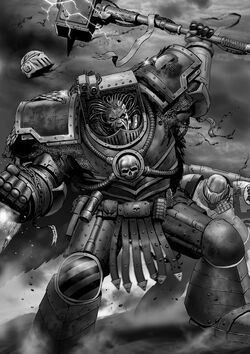
Primarch Perturabo of the Iron WarriorsLegion
Similarity encourages understanding, or at least some would claim so. In the case of Rogal Dorn and Perturabo, Primarch of the Iron Warriors Legion, this sentiment not only falls but shatters under the weight of reality. For rarely could there be said to be two being on the surface who more resembled each other, yet were separated by a greater chasm. Both reserved to the point of taciturn, both unyielding, both sublime artisans of war who prized indomitability and endurance, there was much that would suggest that they should see the world with one set of eyes, that perhaps they should be closer than any others. That bitterest loathing could arise between two such closely matched kin seems incredible, but it was a reality, some say from the first moment of their meeting.
The exact roots and cause of their enmity cannot be known to any save Rogal Dorn and Perturabo, but if one looks closely there appears a pattern both of behaviour and incidents which may offer a clue. Often it seems as though the pair's similarities were the cause of discord rather than understanding. Both were stubborn and more so when challenged, both spoke rarely, and brooded much behind their stone and iron masks. So it was that the silence of one would aggravate the other, the blunt honesty of one roused the other to anger, and the intractability of both ensured that once a dispute was begun neither would yield.
That there were differences between the two cannot be denied, and often these differences may have been the cause of disputes even if they were not the underlying cause. While both Rogal Dorn and Perturabo often favoured siege craft in war, they often differed in its execution. While both were pragmatic, Perturabo often displayed a brutal directness in waging war, applying overwhelming force or sustaining horrific casualties. While Dorn would never baulk or paying such a price for victory, he rarely accepted large numbers of casualties except through necessity. Dorn was an undoubted idealist above all else, Perturabo a pragmatist first and foremost. On such cracked foundations the decades of the Great Crusade heaped pleasures, honours, disparities and mischance, and from the result history reaped an enmity which would take both Primarchs and their Legions to the brink of destruction.
Triumph of Ullanor
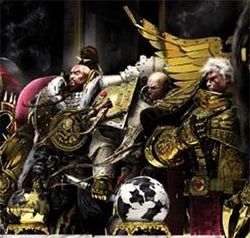
From left-to-right: Primarchs Jaghatai Khan, Lorgar and Rogal Dorn stand at attention during the great Triumph after the successful conclusion of the Ullanor Crusade
The greatest of the nascent Imperium's victories during the Great Crusade came in the form of the defeat of the largest Ork empire ever encountered in the late 30th Millennium. The Ullanor Crusade was a vast Imperial assault on the Ork empire of the Overlord Urrlak Urruk. The capital world of this Greenskin stellar empire, and the site of the final assault by the Space Marine Legions, lay in the central Ullanor System of the galaxy's Ullanor Sector. The Crusade included the deployment of 100,000 Space Marines, 8,000,000 Imperial Army troops, and thousands of Imperial starships and their support personnel. The Ullanor Crusade marked the high point of the Great Crusade's vast effort to reunite the scattered colony worlds of humanity.
The Orks of Ullanor represented the largest concentration of Greenskins ever defeated by the military forces of the Imperium of Man before the Third War for Armageddon began during the late 41st Millennium. Following the defeat of the Orks of Ullanor, the Emperor of Mankind returned to Terra to begin work on his vast project to open up the Eldar Webway for Mankind's use. In his place to command the vast forces of the Great Crusade he left Horus. In the aftermath of this Ullanor Crusade, Horus was granted the newly-created title of "Warmaster," the commander-in-chief of all the Emperor’s armies who possessed command authority over all of the other Primarchs and every Expeditionary Fleet of the Great Crusade.
Jealousies and Rivalries
Following his promotion to Warmaster, Horus had solicited the opinions and advice of all his brother Primarchs on the subject since the honour had been bestowed upon him. Being named Warmaster set him abruptly apart from them, and raised him up above his brothers, and there had been some stifled objections and discontent, especially from those Primarchs who felt the title should have been theirs. The Primarchs were as prone to sibling rivalry and petty competition as any group of brothers. Guided by the shrewd political hand, it was likely, of his Equerry Maloghurst, Horus had courted his brothers, stilling fears, calming doubts, reaffirming pacts and generally securing their cooperation. He wanted none to feel slighted, or overlooked. He wanted none to think they were no longer listened to. Some, like Sanguinius, Lorgar and Fulgrim, had acclaimed Horus' election from the outset. Others, like Angron and Perturabo, had raged biliously at the new order, and it had taken masterful diplomacy on the Warmaster's part to placate their choler and jealousy. A few, like Leman Russ and Lion El'Jonson, had been cynically resolved, unsurprised by the turn of events.
But others, like Roboute Guilliman, Jaghatai Khan and Dorn had simply taken it in their stride, accepting the Emperor’s decree as the right and obvious choice. Horus had ever been the brightest, the first and the favourite. They did not doubt his fitness for the role, for none of the Primarchs had ever matched Horus’ achievements, nor the intimacy of his bond with the Emperor. It was to these solid, resolved brothers that Horus turned in particular for counsel. Dorn and Guilliman both embodied the staunchest and most dedicated Imperial qualities, commanding their Legions' expeditions with peerless devotion and military genius. Horus desired their approval as a young man might seek the quiescence of older, more accomplished brothers.
Following his promotion, Primarch Dorn had come to the 63rd Expeditionary Fleet at Horus' behest, so that the two of them might discuss in detail the obligations and remit of the role of Warmaster. Rogal Dorn possessed perhaps the finest military mind of all the Primarchs. It was as ordered and disciplined as Roboute Guilliman's, as courageous as the Lion’s, yet still supple enough to allow for the flash of inspiration, the flash of battle zeal that had won the likes of Leman Russ and the Khan so many victory wreaths. Dorn's record in the Crusade was second only to Horus', but he was resolute where Horus was flamboyant, reserved where Horus was charismatic, and that was why Horus had been the obvious choice for the position of Imperial Warmaster. In keeping with his patient, stony character, Dorn's Legion had become renowned for siegecraft and defensive strategies. The Warmaster had once joked that where he could storm a fortress like no other, Rogal Dorn could hold it. "If I ever laid assault to a bastion possessed by you," Horus had quipped at a recent banquet, "then the war would last for all eternity, the best in attack matched by the best in defence." The Imperial Fists were an immovable object to the Luna Wolves' unstoppable force.
The Favoured Sons
As the Great Crusade progressed, the Imperial Fists had risen high in honour and in the favour of the Emperor. Ever dependable, they were often used to reinforce flagging campaigns, to hold crumbling fronts and break deadlocked sieges. The Emperor also frequently called on both Dorn and his sons to fight beside him, bestowing this honour on the Imperial fists more than on any other Legion. When the Imperial Fists descended on Ophelia VIII, the Emperor led the assault at the head of 100 Custodians and 100,000 Imperial Fists. Again during another campaign, the Emperor claled on not only Horus and the Luna Wolves, but Dorn and the Imperial Fists to form his vanguard in breaking the Shrouded Dynasties. The Emperor also used Dorn to ensure war and Compliance was achieved according to his wishes and vision. Time and again, in ways large and small, the Imperial Fists acted at the direct order of the Emperor. Other Primarchs and legions blazed a more brilliant trail or spread the Imperial Truth on more worlds, but to many the Imperial Fists were the rock on which the foundations of the Imperium were built.
High in favour and honour though they were, the Imperial Fists status did not sit well with some of their brother-Legions. The animosity between the Imperial Fists and Iron Warriors was well known, but Perturabo and his Legion were not alone in thier resentment. Though few reached the Lord of Iron's pinnacle of spite, others did chafre at the trust place in the Imperial Fists. Dorn's nature did not amellorate matters. Truth speaking, blame and uncompromising in both his ideals and their expression, his manner often aggravated his peers as much as it drew their admiration. It was perhaps this quality which caused the Emperor to pass over Dorn as Warmaster when he withdrew from the Great Crusade. Horus, unlike Dorn, was a master of diplomacy and maintaining a coordianted balance between fractious forces. Where Dorn would cause conflict, Horus would unify, where Dorn would not compromise, Horus would find a way of satisfying all. But even as Horus took up the reigns of the Great Crusade, Dorn was invested as the Praetorian of Terra. Even as Horus would push the Great Crusade on, the Imperial Fists would withdraw with the Emperor to Terra. And with that decision, the fate of the Emperor and all his sons was set.
Fortifying the Imperial Palace
When the Emperor returned to Terra to build a capital world worthy of ruling a million planets, Dorn went as well, commanded by the Emperor to return to the Imperial homeworld and establish a guard around Him there. The Imperial Fists Legion had been chosen as the Emperor's Praetorians. Having always excelled in the construction of fortresses, Dorn was tasked with designing the defences for the Imperial Palace. These would prove to be magnificent, and would be well-tested in the following years as the storm of the Horus Heresy broke over the Imperium. The Primarch Fulgrim once asked if Rogal Dorn thought the Imperial Palace could withstand an assault by the Iron Warriors Legion. Dorn's truthful answer, that it could, infuriated the Iron Warriors' Primarch Perturabo to such a degree that they would almost destroy each other in battle years later during the Heresy. Dorn and the entire Imperial Fists Legion were later recalled to Terra by the Emperor to take up garrison duty there near the end of the Great Crusade. Once the Horus Heresy began, this garrison duty would transform into responsibility for preparing the defences of Terra and the Imperial Palace for the coming invasion of Horus and his Traitor Legions.
Horus Heresy
Before the Imperial Fists could arrive at Terra in full complement, the events of the Horus Heresy overtook them. Stranded for some considerable time by severe Warp storms, the Imperial Fists fleet eventually discovered the badly damaged Loyalist Death Guard frigate Eisenstein, and so learned of Horus' betrayal. However, at first Dorn did not believe Captain Nathaniel Garro and nearly killed him when Garro said that his Brother-Primarch Horus was a traitor to the Imperium and the Emperor. Rogal Dorn was eventually convinced by several members of the Eisenstein survivors of the Istvaan III Massacre, notably Captain Garro, Iacton Qruze of the Luna Wolves and Remembrancer (later Imperial Saint) Euphrati Keeler, that his brothers the Primarchs Horus, Fulgrim, Mortarion, and Angron were staging a full-scale rebellion against the Emperor's rule. Dorn therefore dispatched the bulk of his Legion to the Istvaan System on a war-footing. He himself returned to Terra with his veteran Space Marine companies to bring word of the terrible events personally to the Emperor of Mankind.
Mission To Mars
For those still loyal to the Emperor on the Red Planet, their salvation arrived in the form of a great Imperial expeditionary fleet. Malcador the Sigillite, the Regent of Terra, charged Rogal Dorn with a mission of the most vital importance- to secure the forges of Mars for the Imperial war effort. Dorn informed the Sigillite that he would send his Legion's Champion and First Captain Sigismund, 4 companies of Imperial Fists and a large force of Imperial Army soldiers to secure the forges of Mars. Within the northern hemisphere of the Red Planet lay an arc of Loyalist control—the important munitions manufactorums of Mondus Gamma and Mondus Occulum. Within these two vast industrial complexes the Mechanicum fabricated the weaponry and Power Armour for the Legions of the Space Marines. The forges of Mondus Occulum and Mondus Gamma alone produced the bulk of the armour and weapons of the Astartes. Dorn intended for his force to strike there and capture those forges and once they were occupied, the Imperial Fists and their allies would push outwards and secure the others.
Sigismund's companies landed at Mondus Occulum as the rest of the Imperial expeditionary force was fighting all across the surface of Mars. After a rapid deployment under fire in the shadow of Pavonis Mons, 13 companies of the Imperial Army's Saturnine Hoplites advanced on the Traitors' lines surrounding the forge of Ipluvien Maximal. Further south, 2 of the companies of Imperial Fists and 4 regiments of Jovian Grenadiers (nearly 15,000 Imperial Army soldiers in total) under the command of the Imperial Fists' Captain Camba-Diaz made planetfall in the Mondus Gamma forge complex.
Nothing of the Imperial Fists' mission to Mars panned out the way it had been expected. Camba-Diaz and the Jovian regiments soon became embroiled in a fight for their lives at Mondus Gamma forge, and the Saturnine Hoplites companies tasked with breaking the siege at Ipluvien Maximal’s forge had been repeatedly turned back by the horrifyingly altered weapon-creatures of the Dark Mechanicum. Though the fighting was desperate, Camba-Diaz eventually secured the armour forges and the ammunition silos, but his company was outnumbered a hundred to one. The Traitor Chrom’s troops pushed him back to the landing fields and his losses were grievous. Sigismund knew the Imperial expeditionary force would not be able to hold the forge, but a great deal of essential supplies had been secured for transit to Terra.
Sigismund’s companies had descended upon Mondus Occulum not knowing whether they would have to fight to secure the forge, but it was a relief to find that Fabricator Locum Kane still held true to the Imperium. Sigismund secured vast quantities of munitions for transport back to Terra, including nearly 12,000 suits of Mark IV Power Armour and twice as many Astartes weapons. But the Loyalists had run out of time. Despite the locum's Servitors working at full capacity, it still was not rapid enough, for Sigismund's ship masters informed him of a sizable enemy force closing in, composed of infantry, armoured vehicles, Skitarii and at least two Traitor Titan Legions] comprising nearly 60 war engines in all.
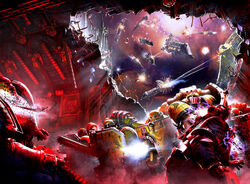
The Imperial Fists face their bitter rivals, the Iron Warriors, during the Horus Heresy
Sigismund's desire to wreak a bloody vengeance on the heads of those who had rebelled against the Emperor warred with the necessity of the mission his Primarch had given him to secure the vital armour and weapons of Kane’s forge that would be needed to defend the Imperial Palace at a later date. Reluctantly he knew that he must stay true to his mission, for the forces arrayed against the Imperial strike force were simply too many and his orders did not allow for the pursuit of futile gestures of defiance. Locum Kane warned the Imperial Fists' First Captain that if both the Mondus Occulum and Mondus Gamma forges fell, the Imperium would have no way of replenishing the combat losses they would sustain in any meaningful way.
After barely a few hours worth of fighting both Mondus Occulum and Mondus Gamma were burning, with vast swathes of their industrial machinery and manufacturing capacity destroyed. The loss of such irreplaceable technology and knowledge, would be felt by the Imperium for many millennia to come. Like comets launching from the surface of Mars, the Imperial starships fled for the heavens. Astartes and Imperial Army vessels jostled in the sky in their haste to depart the Red Planet. Barely a thousand Loyalist warriors were able to escape from the planet's surface before the manufactorums fell into the hands of the Traitors. The desperate rearguard action of the Astartes and other Loyalists on Mars and the sacrifice of many thousands of lives at least had secured tens of thousands of suits of newly-fabricated Mark V and Mark VI Space Marine Power Armour and other vital materiel that would ultimately prove to be the edge for the forces of the Imperium in the campaign against the Traitor Legions of Horus Lupercal.
Battle of Terra
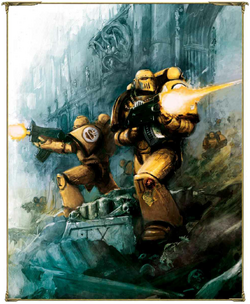
Imperial Fists defending the Imperial Palace during the Battle of Terra
Along with the White Scars and the Blood Angels Legions, the Imperial Fists put up a heroic defence of the Imperial Palace from the Forces of Chaos during the Battle of Terra, that has since passed into legend. Having originally constructed the Imperial Palace, it was also Rogal Dorn who prepared the Palace's defences at the Emperor's request to face the Traitor Legions of Horus. Then, when all hope seemed lost, they accompanied the Emperor in his last battle aboard the Warmaster Horus' Battleship Vengeful Spirit. It fell to Dorn to discover the bodies of the Emperor, Horus and Sanguinius after the final drama had run its course. His grief was immense. Until that point Dorn had been true, noble and enduring, but now he became an avenging son. While the Ultramarines maintained order within the battered Imperium, the Imperial Fists hunted down the Traitor Legions, levelling fortress after fortress. Dorn led them, dressed in the black of mourning, his customary mercy set aside until the guilty were punished. While others like the Ultramarines' Primarch Roboute Guilliman shaped the new Imperium's institutions during the Reformation, Dorn immersed himself in implacable justice. It was rumoured that he saw the Emperor's death as his personal failure and his crusade as penance. After all, were the Traitors not his brothers? Whatever the cause, Rogal Dorn was absent from the highest councils until he was summoned back to Terra when Roboute Guilliman, Primarch of the Ultramarines, presented his Codex Astartes as the future of the Space Marines and the Imperial military machine.
Pillar of Bone
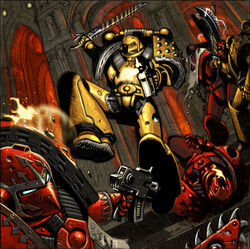
Imperial Fists valiantly defend the Imperial Palace during the Battle of Terra
The Pillar of Bone is believed to be a monument raised on Terra to the Imperial Fists' courage in an unnamed campaign. But in reality it is actually a sacred holy relic to those privy to the truth within the Imperial Fists. The Pillar is the last remnant of the once-great Imperial Fists fortress-monastery on Terra. It was destroyed during the Horus Heresy in the midst of the Battle of Terra, but, to most of the huddled masses of the Imperium, the Heresy is now no more than a legend and few would dare to openly claim that the Forces of Chaos had ever set foot on the sacred ground of Terra. In the holes torn from the column by the Bolter fire of the Traitor Legions were the scrimshawed hands of Imperial Fists Battle-Brothers. Part of the sacred duties given to Imperial Fists Chaplains was to bring new relics of the Chapter to the Pillar, but at times they would also recruit those pilgrims who came to Terra from all across the galaxy into the Chapter if they were deemed worthy of becoming Aspirants. It was at this sacred site that future-Captain (and Imperial Fists' hero) Darnath Lysander was recruited after he had survived multiple misfortunes, including the slaughter of his entire family, to make it to the holy soil of blessed Terra. It seemed to the Imperial Fists Chaplain that recruited him that the young pilgrim surely had the blessings of Rogal Dorn upon him. Such intuition would be proved right again and again during Captain Lysander's career.
Column of Glory
Another of the greatest relics of the Imperial Fists Chapter also rests on Terra. Known as the Column of Glory, this structure is a massive crystalline pillar studded with the shattered armour of all those Imperial Fists Astartes who fell in defence of Terra and the Imperial Palace during the final battle of the Horus Heresy. The Column of Glory stands as an eternal testament to the sacrifice the Sons of Dorn made in defence of the Emperor of Mankind and the homeworld of humanity.
The Codex Astartes Crisis
It was Rogal Dorn who discovered the bodies of the Emperor, Horus and the Blood Angels Primarch Sanguinius after the final drama had run its course aboard the Vengeful Spirit. Dorn's grief was immense. Until that point, he had been true, noble and enduring, but now he became a reckless avenging son. While the Ultramarines Legion maintained order within the wounded Imperium, the Imperial Fists hunted down the Traitors that had turned their back on the Emperor, levelling fortress after fortress during the Great Scouring. Dorn immersed himself in implacable retribution until he was summoned back to Terra when Roboute Guilliman presented the Codex Astartes as the future of the Space Marines.
The Second Founding
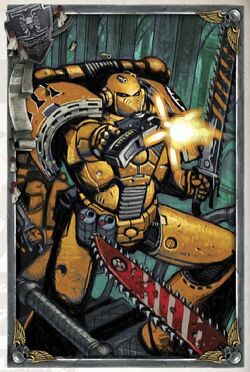
Imperial Fists Assault Marine during the Horus Heresy
While many Primarchs welcomed the Codex Astartes, Rogal Dorn initially refused to have his Legion broken down into Chapters. Leman Russ and Vulkan agreed with Dorn, but Corax and Jaghatai Khan supported Guilliman. Tension rose as neither side backed down, and it seemed inevitable that civil war would once more engulf the Imperium. Only at the brink, when the newly founded Chapters and the old Legions were preparing for battle, did Dorn realise that his self-imposed quest for vengeance had blinded him to wisdom. He realised that the Ultramarines, the other Space Marine Chapters, the Imperial Navy and the newborn Imperial Guard would all initiate another civil war with the Imperial Fists rather than allow them to avoid accepting the dictates of the Codex. Despite his love for the Space Marines of his Legion, Rogal Dorn loved the Imperium the Emperor had created too much to subject it to another terrible conflict in the wake of the horrors of the Horus Heresy. With a heavy heart, he acquiesced to the reforms ordained by Guilliman. So it was that Dorn finally relented and agreed to the Founding of three new one-thousand-man strong Chapters from his Legion -– the Crimson Fists, Black Templars and the Soul Drinkers. Rogal Dorn's willingness to swallow his pride and embrace the Codex Astartes did much to reassure the High Lords of Terra, and when the Imperial Fists emerged from the Second Founding, their adherence to the tenets of Guilliman's tome was matched only by the Ultramarines themselves.
Iron Cage
The enmity between the Iron Warriors and the Imperial Fists began in the Great Crusade; Perturabo was ever jealous of the esteem in which Rogal Dorn was held, seeing conceit and arrogance where others saw nobility. When Perturabo sided with the rebel Horus, the seeds of rivalry grew into bitter loathing. The Imperial Fists, like the Iron Warriors, were masters of the siege and as such relied greatly on the use of artillery and heavy weapons in combat, although not to the extent of their traitorous former brethren. Their shared specialisation led to the development of a great rivalry and eventually hatred between the two Legions and their Primarchs during the Great Crusade, and after the Heresy the Imperial Fists continued to pursue the Iron Warriors for some time, culminating in the incident known as the battle of the "Iron Cage" on the world of Sebastus IV.
The Imperial Fists suffered horrendous losses during the campaign known as the Iron Cage
Perturabo, the Primarch of the Iron Warriors Traitor Legion, was a master of fortification whose writings had been retained by Roboute Guilliman in his Codex Astartes. Dorn had always been Perturabo's match in the arts of siege warfare and combat engineering, and, what was more, his honest warrior's soul was indignant. The Iron Warriors had rebelled against their rightful lord and lost. Their master, Horus, was dead and the Emperor still ruled over the galaxy. Yet still they dared raise their heretical banners over another Imperial world as if they had some right to be there. Dorn would not tolerate this. Without his customary caution and planning, Dorn led his Legion into the heart of the Iron Warriors' fortifications, a massive set of interlocking defences designed to look like an 8-pointed Star of Chaos that was known as the Eternal Fortress. The fortress was located on Sebastus IV, a world that became known in legend as the Iron Cage. The battle should have favoured the treacherous trench-fighters of the Iron Warriors, but the Imperial Fists endured. They countered every ambush and fought their way out of every trap set by the Chaos Space Marines. Rogal Dorn was a colossus who personally turned back attack after attack. Ammunition expended, the Battle-Brothers of the Fists fought in half-flooded trenches with combat knives, giving and expecting no quarter. Eventually it became apparent that the Iron Warriors could not finish them. For all their skill and ferocity, as devotees of Chaos the Iron Warriors lacked the faith to make the ultimate sacrifice that victory demanded. While they paused, the Ultramarines intervened; Guilliman had decided that Perturabo's destruction was not worth the loss of Rogal Dorn and had brought his Legion to drive off the Iron Warriors.
Cleansed by their sacrifice in the Iron Cage, the Imperial Fists immediately began their reorganisation into separate Chapters as required by the Codex Astartes. For the next two decades the remaining Imperial Fists went into retreat to rebuild their numbers, their Successor Chapters taking to the field in their stead. Dorn used this time to retrain the Chapter to embrace all aspects of the Codex Astartes. When the Imperial Fists later emerged, their adherence to the Codex was matched only by the Ultramarines.
Rogal Dorn's Death
Rogal Dorn is believed to have "died" in 781.M31 whilst fighting a Chaos Fleet during the 1st Black Crusade that had emerged from the Eye of Terror under the command of the returned Abaddon the Despoiler, with a vastly outnumbered Imperial force. Seeing the importance of attacking the enemy fleet while they were still preparing to invade Imperial space, Dorn relied on hit-and-run attacks until his reinforcements could arrive. Dorn "died" onboard the Chaotic Despoiler-class Battleship Sword of Sacrilege after leading a desperate attack on its bridge. The only trace of the missing Primarch uncovered by the Imperial Fists' subsequent searching was a single fist. Dorn's skeletal hand was returned to the Phalanx where, over the years, it has been scrimshawed, the bones intricately engraved with the heraldry of all the Imperial Fists Chapter's previous Chapter Masters. Only the current Imperial Fists Chapter Master has the right to engrave his name upon the bones. Even with minuscule script, ten thousand standard years of history have left the bones covered with names, giving a list of the Imperium's greatest heroes. Each bone corresponds to former commanders of the Chapter. For instance, the left hand first metacarpal contains the names of Chapter Masters Bronwin Abermort, Maximus Thane, Kalman Flodensbog and many others, while the first phalanx of the thumb bears the name Ambrosian Spactor, and so forth. The Hand of Dorn is the Imperial Fists' holiest icon and it serves as a reminder of sacrifice and commitment. So it is that, throughout the Imperial Fists’ history, from the Ork Onslaughts of the 32nd Millennium to the 13th Black Crusade, they have drawn inspiration from their Primarch's remains and resolved to defeat their foes or die in the attempt. Whether the fist actually belongs to Rogal Dorn or his remains lie elsewhere, is unknown. It is even possible that Dorn survived the assault upon the Sword of Sacrilege; whatever his fate, its truth is known only to the Emperor at present.
Notable Campaigns
- First Pacification of Luna (ca. 800.M30) - This early Imperial campaign was the first operation mounted by elements of the early Space Marine Legions beyond the skies of Terra. The Unification Wars were still raging across the surface of Mankind's birth world. Luna was the bastion of a conglomeration of resurrectionist gene-cults whose members believed that human nature was both fractal, fractured and transcendent. Each of these Selenar gene-cults clung to a different set of archetypes. Every cult member was a product of creation by the Selenar gene-wrights according to formulae crafted in the Dark Age of Technology. Resurrected in body time and time again they sought to distill the true personification of a single human archetype. In their subterranean complexes the cults were powerful, insular and resistant to the Imperial Truth. The Imperials would have normally dealt with these insular cults in the usual matter they handled all of the other Terran factions and techno-barbarian states that refused to accept the rule of the Emperor of Mankind -- by obliteration. The fact that the Selenar gene-cults had something that the growing Imperium needed complicated such action. The Selenar responded to the Imperial entreaties for alliance with silence. As the threats of the Imperium soon began to outnumber its offers, the Selenar cults began to gird themselves for war. So it was that the Emperor finally ordered Luna to be pacified by the sword, their superstitious beliefs cast down before the Imperial Truth and their gene-craft yoked to the needs of the Imperium. To this task the Emperor set three of his newborn Space Marine Legions most suited to this purpose on what some Imperial chroniclers name as the first true battle of the Great Crusade. The combined force of the VII, XIII and XVI Legions (later named the Imperial Fists, Ultramarines and Luna Wolves) lifted from the surface of Terra in a scattering of rocket flame. The as yet unnamed XVI Legion had been chosen to serve as the Space Marine force's vanguard, and had brought its full strength to bear. Cutting power to their assault craft, the Astartes of the XVI Legion drifted silently towards Luna through the void like arrows fired into the night. As the smaller wave of assault craft belonging to the VII and XIII Legions approached the airless world, the Selenar defensive weapon systems embedded in Luna's surface lashed the oncoming Imperial force. The XVI Legion's assault craft, unlooked for and unseen, struck their targets like a dagger in the night. Within six hours of the first shot being fired, Luna had been pacified and brought into Imperial Compliance, the first off-world conquest of the Imperium of Man. Faced with annihilation, the surviving Selenar cultists bent the knee instead, their surrender communique transmitted to Terra calling for the Emperor to "call off his wolves." Broken and humbled, the enslaved gene-wrights of Luna would help forge the next generation of Space Marine who would carry out Mankind's conquest of the stars. As for the XVI Legion, they had earned their name -- the Luna Wolves.
- Pacification of Schravaan (Unknown Date.M30) - This was a joint Imperial Compliance action conducted by the Imperial Fists, Iron Warriors, Emperor's Children and the Luna Wolves Legions against the xenos Badoon on the world of Schravaan. The Iron Warriors won a great victory when they stormed the final refuge of the Badoon. They breached the defences and held while the other Legions carried the city beyond. During the following victory feast, Horus proclaimed Perturabo the greatest master of siege warfare in the Great Crusade. Fulgrim, the Primarch of the Emperor's Children then inquired to his brother Rogal Dorn whether he thought even the defences of the Imperial Palace could resist an assault by the Iron Warriors, in which Dorn replied that he regarded the defences as being proof against any assault if well-planned. Perturabo flew into a rage and unleashed unfounded accusations against his brother. After this the two rarely spoke, and their Legions would not serve in the same campaign for the remainder of the Great Crusade.
- Pacification of Necromunda (Unknown Date.M30) - The Imperial Fists won a major victory against the Orks upon the ash wastes on the Hive World of Necromunda. The Hive Lords consented to recruits being drawn from their population in gratitude and a Fortress-Chapel was duly consecrated, but the Imperial Fists continued to refuse to accept any special rights on the worlds where their Legion recruited. Throughout the Crusade they refused to garrison or claim tithes of newly conquered worlds, instead opting to remain a military unit with none of the responsibilities that came with having a homeworld.
- Battle of Gyros-Thravian (Unknown Date.M30) - The Battle of Gyros-Thravian was a massive joint Imperial Compliance action carried out by three Space Marine Legions, composed of the Luna Wolves, Death Guard and Imperial Fists against the extremely powerful Ork Warboss Gharkul Blackfang, one of the most powerful Ork warlords ever encountered up until that time. Despite the strength arrayed against the vile Greenskin, it was the Imperial forces who were soon on the verge of defeat. It was then that the Emperor Himself, aboard his flagship Bucephelus, came to the aid of His sons. He personally led a force composed of 1,000 Legio Custodes into the heart of the mighty Ork horde. Blackfang was confronted by the Emperor and killed atop his Gargant while the Custodians proceeded to lay waste to the rest of the Greenskin horde. The Custodians accounted for the slaughter of the Orks, slaying over 100,000 of the savage xenos, with the loss of only three Custodians. Following their momentous victory, the Emperor commemorated the Custodians' sacrifice by engraving the names of the three fallen Custodians into his own personal Power Armour.
- Pacification of the Cheraut System (984.M30) - This was an Imperial Compliance action during the Great Crusade jointly conducted by Astartes from the Imperial Fists, Night Lords and Emperor's Children Legions. As the Primarch of the Night Lords Legion suffered from one of his violent fits, Primarch Fulgrim rushed to Konrad Curze's aid. The Night Lords Primarch confided to his brother of the dire visions that he had seen; his death at the hands of their father, that many of the Primarchs would die fighting amongst themselves, and that the light the Emperor brought to his homeworld of Nostramo would destroy it forever. Troubled by these dire portents, Fulgrim confided in his brother Rogal Dorn. Dorn took exception to this slight on the Emperor's name and confronted Curze. Shortly thereafter, Dorn was found unconscious and bleeding with great gouges of flesh ripped away from his torso. Crouching above his fallen brother was the pallid form of the Night Haunter, weeping. Wracked with self-loathing and guilt, Curze was taken into custody and exiled to his chambers, while his brother Primarchs discussed what actions to take against their deeply disturbed brother. Hours later, when the council of Primarchs finally disbanded, they found Night Haunter missing and the Imperial Fists' honour guard watching over him butchered. By the time the Primarchs gave chase, Night Haunter had already disappeared with his Legion into the Warp.
- Battle of Phall (005.M31) - During the Horus Heresy, at the command of the Warmaster Horus, a large Iron Warriors contingent was sent to halt the encroaching Imperial Fists Retribution Fleet that had originally been sent to Istvaan III to reinforce the beleaguered Loyalists. However, the Retribution Fleet had proven unable to reach its destination due to the Warp Storms created by the Chaos Gods to prevent Imperial reinforcements from reaching the Istvaan System. As such, the Retribution Fleet, containing approximately one-third of the Imperial Fists Legion's total forces, had established itself within the nearby Phall System while it waited for the Warp currents to stabilise. The Traitors could not allow such a strong complement of Loyalist Astartes to infiltrate the area of space under their control, for they could seriously disrupt preparations for the attack on Terra. Commanding hundreds of warships, the Primarch Perturabo led his fleet in a sudden and devastating attack upon the Imperial Fists fleet. Over a dozen vessels were ripped apart by the brutal hail of fire from the Traitor vessels. The Imperial Fists fought back, devastating the lead ships of the Iron Warriors' fleet, tearing them apart in a vicious firestorm. The Loyalists gained the initiative in what would be remebered as the Battle of Phall and managed to repel the Traitors' surprise attack, despite severe losses at the start of the engagement. Unfortunately, at that same time, the Retribution Fleet's Astropaths managed to make contact with Terra and received a direct order from Rogal Dorn recalling the Retribution Fleet to Terra to prepare the defences of the Imperial Palace. Launching a counterattack, the Imperial Fists drove off the embattled Traitor fleet and managed to break orbit and manoeuvre to their jump points, where they entered the Warp and made for Terra.
- Battle of Terra (ca. 014.M31) - After the infamous Drop Site Massacre on the world of Istvaan V, the Imperial Fists' Primarch Rogal Dorn was charged by Malcador the Sigillite to prepare the defences of Terra and the Emperor's Imperial Palace. During the closing days of the Horus Heresy, the Warmaster Horus and his Traitor Legions attacked Terra, the seat of the Emperor's Imperium of Man, in a final attempt to overthrow his father and usurp the throne for himself. During the Battle of Terra the Imperial Fists, Blood Angels and White Scars were the three Loyalist Space Marine Legions that helped defend the Imperial Palace from the hordes of Chaos. Three entire Titan Legions of the Adeptus Mechanicus and close to 2 million soldiers of the Imperial Army stood alongside the Loyalist Astartes to face the Traitors in a battle that would determine the fate of Mankind for the next 10,000 standard years. After nearly two months of constant siege, the Warmaster made one last gamble and lowered the Void Shields of his flagship, the Vengeful Spirit. Taking advantage of this opening, the Emperor, a cadre of Legio Custodes, the Primarchs Rogal Dorn and Sanguinius and a force of Imperial Fists and Blood Angels Astartes teleported aboard the Warmaster's Battle Barge. It fell to Dorn to discover the bodies of the Emperor, Horus and Sanguinius after the final drama had run its course. He returned the mortally wounded Emperor to His palace. Following the Master of Mankind's final instructions, Dorn helped inter his father within the Golden Throne, where the Emperor has sat for the last ten millennia.
- Great Scouring (Unknown Date.M31) - Following the end of the Horus Heresy, Dorn became an avenging son. Whilst the Ultramarines Legion maintained order within the battle-scarred Imperium, the Imperial Fists hunted down the Traitor Legions, leveling fortress after fortress during the Imperial campaign of vengeance against the Forces of Chaos known as the Great Scouring. Dorn led his Imperial Fists, dressed in the black of mourning, his customary mercy set aside until the guilty were punished. Whilst others shaped the new Imperium, Dorn immersed himself in implacable justice. Rogal Dorn remained absent from the highest councils until he was summoned back to Terra when Roboute Guilliman presented his Codex Astartes as the future of the Space Marines.
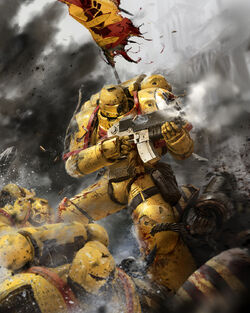
Trapped within the Eternal Fortress, the Imperial Fists fight a desperate battle against the Iron Warriors Traitor Legion
- The Iron Cage (Unknown Date.M31) - Upon the world of Sebastus IV the traitorous Iron Warriors, bitter archenemies of the Imperial Fists, laid an ingenious trap to ensnare Rogal Dorn and his Legion. Heedless of the inherent danger, the Primarch ordered the Imperial Fists to attack the Iron Warriors' Eternal Fortress—later referred to as the Iron Cage by the surviving Imperial Fists. The battle should have favoured the treacherous trench-fighters of the Iron Warriors, but the Imperial Fists endured. For all their skill and ferocity, as devotees of Chaos the Iron Warriors lacked the faith to make the ultimate sacrifice that victory demanded. While they paused, the Ultramarines intervened; Guilliman had decided that Perturabo's destruction was not worth the loss of Rogal Dorn and had brought his Astartes to drive off the Iron Warriors.
- 1st Black Crusade (ca. 781.M31) - Abaddon the Despoiler, the new Warmaster of Chaos Undivided, made his first attempt to launch a new offensive against the Imperium of Man following the Horus Heresy, and when he unleashed the 1st Black Crusade and the First Battle of Cadia. Rogal Dorn "died" fighting aboard a Chaos Space Marine vessel after attacking a Chaos warfleet that emerged from the Eye of Terror and vastly outnumbered the Imperial defenders. Seeing the importance of attacking the enemy fleet whilst they were still preparing to invade Imperial space, Dorn relied on hit-and-run attacks until his reinforcements could arrive. Dorn "died" aboard the Chaotic Despoiler-class Battleship known as the Sword of Sacrilege after leading a desperate attack on its bridge. When Dorn and his elite Honour Guard stormed the bridge they were cut down to a man. Later, the Imperial Fists would pick up an escape pod from one of their own ships present at the battle, which contained the weapons and Power Armour of their beloved Primarch. The only sign of Dorn was a single skeletal fist that the Imperial Fists believed belonged to the Primarch. What fate ultimately befell Rogal Dorn, and whether he truly died or not, has yet to be determined with absolute certainty.
- The Beheading (546.M32) - The Imperial Fists participated alongside forces from the Sable Swords and Halo Brethren Chapters in the hunt for the Officio Assassinorum Grand Master Drakan Vangorich after he had all the members of the High Lords of Terra assassinated.
- Age of Apostasy (378.M36) - At the height of the Age of Apostasy, an elite Space Marine strike force composed of the Imperial Fists, Black Templars, Fire Hawks, Soul Drinkers, and the forces of the Adeptus Mechanicus assaulted the renegade High Lord Goge Vandire's seat of power—the Ecclesiarchal Palace on Terra - effectively ending Vandire's "Reign of Blood" and his attempts to assume dictatorial control of the Imperium.
- Siege of Balle Alpha (755.M38) - When the Orks of WAAAGH! Gogard besiege the walled capital of Balle Alpha, they find themselves drastically outmatched. Bolstered by a detachment of Imperial Fists, the defenders inflict grievous losses upon the advancing greenskin horde and when a Blood Angels relief force arrives, the barbarous aliens' destruction is assured.
- The Blood of Khaine (585.M40) - Captain Lysander and the Imperial Fists' 2nd Company successfully board and capture the Eldar Cruiser Blood of Khaine.
- Siege of Haddrake Tor (659.M40) - The Imperial Fists take part in the three-year-long campaign to recover the world of Haddrake Tor from the clutches of Chaos. In the course of the campaign, the 1st Company's Captain Kleitus is mortally wounded, but passes on a Imperial Fists' relic, the Thunder Hammer known as the Fist of Dorn, and the command of the 1st Company to Darnath Lysander before his untimely death. The newly elevated Lysander leads the remaining Imperial Fists against the Chaos defenders, earning a glorious victory. On his return to the Phalanx, Lysander is formally elevated to Captain of the Chapter’s 1st Company.
- Lost in the Warp (970.M40) - The Imperial Fists Strike Cruiser Shield of Valour is lost in the Warp, taking with it Captain Lysander and a bodyguard of 1st Company Veterans.
- The 102nd Feast of Blades (749.M41) - All twelve competing Chapters who are successors of the Imperial Fists Legion are in attendance at this year's Feast of Blades. The Iron Knights' champion, Hervald Strom, wins the competition after narrowly defeating the Imperial Fists' champion, Demitrius Valor, in a ritual duel.
- The Saviours of Cadia (777.M41) - A sizable Black Legion warband exits the Eye of Terror. Cadian Shock Troops Imperial Guard regiments slow the Traitors' onslaught, but it takes a determined counter-attack from the Imperial Fists to throw the Chaos Space Marines back into the Warp.
- Conquest of Uttu Prime (Unknown Date.M41) - Nemesor Zahndrekh's ultimatum had given the Imperial defenders of Uttu Prime one solar month to withdraw, as was required by the ancient Necron codes of battle. Yet, when the deadline had passed, the foolish humans had not availed themselves of this most generous of offers. Indeed, whilst the Necron fleet held in intentional abeyance in orbit around Uttu Prime's desert moon, four regiments of the Imperial Guard's Catachan Jungle Fighters and three companies of Imperial Fists Space Marines had come to reinforce the contested world. So it was that when Zahndrekh finally launched his assault and began the campaign later known as the Conquest of Uttu Prime, he did so against a planet with formidable defences. However, when his courtiers argued against prosecuting the war to completion, the Nemesor merely issued a grating laugh and sent the interstitial command that set his fleet in motion. Zahndrekh initially ignored Uttu Prime's outlying cities, focussing his assault on Fort Anan, the planetary capital. Zahndrekh's first attack wave was a dozen squadrons of Doom Scythe fighter craft. They swarmed over Fort Anan's fortifications, death rays raising great furrows of twisted metal and stone as they ploughed through bastions, ferrocrete walls and the luckless human defenders therein. To their credit, the humans put up a spirited resistance. Hydra Flak Tanks and Defence Lasers scoured the skies, driving off or blasting apart many of the swarming Necron aircraft. Yet each time a Doom Scythe was destroyed, another immediately peeled off from the main group to exact vengeance. Soon, Fort Anan was stripped of aerial defences, and the landings began. Transport craft followed in the wake of the first attack wave. Night Scythes flew low over the wreckage of crashed Necron flyers and Imperial bastions. Small arms fire scattered across the Night Scythes' armoured hulls as their flickering teleportation invasion beams delivered Zahndrekh's assault troops into the heart of the humans' defences. Phalanx upon phalanx of Immortals and Necron Warriors stalked through the fresh ruins, Gauss Weapons blazing in unnaturally precise volleys as they drove the Catachans back. Here and there, an officer's barked orders held the Guardsmen in line, but where those commanders fell, the Imperial lines went into full retreat. It was as the attackers' lines reached the Planetary Governor's citadel that the Imperial Fists finally made their presence known. Thunderhawk gunships screamed through the skies, shredding the oncoming Necron Warriors with Heavy Bolter fire and blasting Immortals limb from limb with missile strikes. As the gunships touched down amongst the rubble to disgorge Space Marines into the fray, the Necrons shifted to defensive protocols and awaited reinforcements. Alas for the Imperial Fists; from his vantage point in orbit, Zahndrekh had marked the approach of the Thunderhawks long before they had made their presence known planetside. Thus, even as the roar of Bolter-fire echoed through Fort Anan's ruins, a shadow fell over the battlefield as the massive Necron Megalith descended. The Megalith was no ordinary war engine, but a vast floating fortress. Green fire lanced out from its flanks, blasting Thunderhawks from the air or crippling them on the ground. As the shadow grew larger, chunks of the Megalith's understructure broke away, the blocks falling lazily to the ground. They were no mere wreckage, but Monoliths detaching from the mothership's hull. As each touched down, it added firepower to the barrage assailing the Imperial Fists. The Space Marines must have determined that they were doomed, but duty and stubborn tenacity made them redouble their efforts. Lascannon and Multi-melta fire flickered through the ruins, the beams converging to pierce the Monoliths' necrodermis hulls. Assault Squads threw themselves at the Necron phalanxes, Chainsword teeth screaming as they ripped through living metal bodies. However, the Megalith was now close enough to the ground to bring its invasion beams into play. Ghoulish viridian light flickered over the battlefield as the teleport beams activated, delivering Doomsday Arks, legions of Necron Immortals, as well as Zahndrekh and his personal Lychguard, into the thick of battle. Those Space Marines that yet survived now withdrew to the Planetary Governor's citadel, but three Doomsday Arks converged their fire on the great adamantium gate. For a handful of moments it glowed an angry red, then burst into fragments with an ear-splitting crack. As the Imperial Fists fell back deeper into the citadel, Zahndrekh raised his Warscythe in salute to the doomed foe. Then the scythe swept down and the Nemesor led his triumphant army of the undying through the ruined gate. Shortly thereafter, Fort Anam had fallen. The rest of Uttu Prime would soon follow, and another world would be added to the territory of Gidrim -- and the growing personal domain of Nemesor Zahndrekh.
- The Tyros Gulf Campaign (830.M41) - The Imperial Fists' Chapter Master, Vladimir Pugh, leads two-thirds of his Battle-Brothers into the Tyros Gulf to retake a string of worlds conquered by Rogal Dorn during the Great Crusade and subsequently lost to the Imperium during the Horus Heresy. Illic Nightspear, an Eldar of Craftworld Alaitoc, launches a surprise attack against the Imperial Fists on the world of Lobas. Pugh is only saved from a sniper's bullet when the Chapter Champion, Demitrius Valor, heroically sacrifices himself. The Eldar are forced to withdraw shortly thereafter, when the Imperial Fists' 6th Company deploy via Stormraven to reinforce their Chapter Master's position.
- The 103rd Feast of Blades (849.M41) - Despite suffering heavy wounds in the Vinculus Crusade, Hervald Strom emerges triumphant once more. Never before has one Chapter, let alone one champion, prevailed in two successive Feasts of Blades.
- The Krandor Rebellion (853.M41) - The Krandor Rebellion escalates when Alpha Legion forces arrive and the Planetary Defence Forces crumble. The Imperial Fists, Fire Lords and Revilers launch a counterattack to secure vital Imperial artefacts before Exterminatus is declared.
- The 104th Feast of Blades (949.M41) - The ravages of war dictate that only eight Chapters are in attendance at this year's Feast of Blades, but the tradition is still observed. Supremacy is tied between the Imperial Fists and Crimson Fists Chapters when their nominated champions simultaneously ram their swords through each other's primary heart in a closely fought duel.
- The Siege of Fort Mork (955.M41) - The Imperial Fists' 4th and 9th Companies lay siege to the Ork mega-stronghold of Fort Mork, and are nearly overwhelmed when thousands of Orks pour out of the gates to meet them. As one, the Imperial Fists level their weapons and lay down a withering hail of fire, every shot punching an Ork off its feet. The horde finally breaks after three days of throwing themselves at the Fists' lines, only to be annihilated by the combined fire of a dozen Thunderfire Cannons before they can reach the safety of their fortress.
- A Hero Returns (963-966.M41) - The Imperial Fists' vessel Shield of Valour re-enters normal space after being lost in the Warp for nearly a millennium, only to be disabled by the firepower of three Iron Warriors orbital fortresses above the Daemon World of Malodrax. Captain Lysander and his bodyguard are captured, taken back to the Iron Warriors' fortress and tortured by the Chaos forces. It is several solar months before Lysander and his fellows, with no armour or weapons, manage to escape and find their way back to the Chapter, which had long since accepted their deaths. Lysander spends nearly a standard year undergoing ruthless tests of his identity and purity before being reinstated as Captain of the 1st Company.
- Scouring of Malodrax (966.M41) - The 1st Company's Captain Darnath Lysander leads the Imperial Fists to the Chaotic fortress-world of Malodrax and successfully scours their ages-old enemies, the traitorous Iron Warriors, from the planet.
- Khai-Zhan Uprising (968.M41) - The Imperial Fists 5th and 9th Companies are deployed alongside four Cadian Imperial Guard Regiments to the world of Khai-Zhan to suppress the heretical Khai-Zhan Uprising against Imperial authority. The Imperial Fists force is instrumental in countering the warband of Night Lords Chaos Space Marines taking part in the uprising, laying siege to the heavily fortified citadel called the Palace of Peace.
- The Ghallamore Cleansing (975.M41) - The daemon legions of the Daemon Prince Skulltaker overrun the world of Ghallamore. The 2nd Company of the Imperial Fists join forces with Brother-Captain Arvann Stern and his Grey Knights Brotherhood to scour the planet of the daemonic taint.
- Nimbosa Crusade (993.M41) - The Imperial Fists took part in the Nimbosa Crusade alongside one of their Successor Chapters, the Black Templars, reclaiming the Imperial world of Nimbosa from the encroaching Tau Empire.
- Defence of Miral II (997.M41) - Captain Lysander and his battle group intercept a tendril of Hive Fleet Leviathan on the world of Miral II. The Imperial Fists establish a series of fortifications in time to meet the Tyranid onslaught, holding firm against constant attack by overwhelming numbers of Tyranid bioforms. Tactical and Devastator Squads rain fire upon the swarm whilst Lysander leads 1st Company Veterans to bolster the battle-line wherever the Tyranids are on the verge of breaking through. Though the Imperium's tacticae predict the Imperial Fists can hold out for no more than six solar days, they stoically fight on until the last Tyranid dies to Bolter fire at the walls of Bastion XVII on the seventh, and final, day of the war.
- 13th Black Crusade (999.M41) - The Imperial Fists arrived at the Cadian Gate as part of the massive Adeptus Astartes reinforcement of the region during the 13th Black Crusade, five companies smashing into the forces of the Archenemy at Cadia as soon as contact was made. After an initial void engagement that saw the Chapter's Battle Barges and Strike Cruisers take a fearsome toll on the Chaos warfleet besieging the Cadia System, three of the companies carried out a combat drop on Cadia itself, while the other two dispersed to bolster the defences in surrounding sectors, including reinforcing the Iron Hands Chapter at their homeworld of Medusa. The 1st, 2nd and elements of the 3rd Companies were instrumental in the defence of key points on Cadia, manning the walls of a number of fortresses with the steadfast resolution for which they are famed throughout the Imperium. In these actions, the 2nd Company was noted for exceptional acts of gallantry, overcoming a horde of mutants from the notorious Stigmatus Covenant Chaos Cult that numbered almost 10,000 traitorous fanatics. At the height of the assault on the walls of Kasr Vasan, the company commander, Captain Tialo, gave his life holding a breach in the fortifications, repelling a mob of mutants numbering several hundred before succumbing to the terrible wounds inflicted upon him. The Captain's body refused to die, however, and was held in stasis by the Chapter's Techmarines, who hoped to inter it within the mighty form of a Dreadnought so that the renowned warrior might continue to battle the forces of darkness beyond the death of his mortal body.
- Second Siege of Hyrdra Cordatus (565.999.M41) - The Imperial Fists 3rd Company suffers shocking casualties holding the Adeptus Mechanicus world of Hydra Cordatus against the hated Iron Warriors. In time, every one of the defenders is slaughtered and the Iron Warriors claim a tithe of precious, uncorrupted Imperial Fists gene-seed which they will use to replenish their dwindling numbers.
The Phalanx
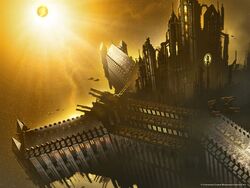
The Phalanx, the mobile Fortress-Monastery of the Imperial Fists
The Imperial Fists were and are makers and breakers of fortresses, but the greatest fortresses they built were amongst the stars. The Legiones Astartes are warriors of the stars, but the Imperial Fists made the cold void their battlefield of choice. While there were great and grand fortresses on the ground both to defend and assault aplenty in the Great Crusade, the greatest sieges and defences were in fact fought in the murderous environment of space. The defence of star systems, the creation of kill zones and intersecting orbits were skills that the Imperial Fists honed to a keen edge on the grindstone of thousands of battlefields. To them the methods of defending or taking a position, whether terrestrial or void-borne, were the same in principle even if different in application. After all what were starships but fortresses of stone and metal broken free of gravity? It was an approach which saw them become the pre-eminent masters of high-intensity void warfare among the Space Marine Legions, and peerless in the spheres of boarding assault and close quarter ship-to-ship combat.
Of these war bastions of the stars, the greatest was the Phalanx. A pre-Imperial relic of vast size and unimaginable power, Rogal Dorn rebuilt the cold wreck, found orbiting Inwit, where it had drifted dead since the Dark Age of Technology, and presented it to the Emperor on their reuniting. Although ponderous and a difficult voyager in the Warp, this titanic star fortress was nevertheless a space-curried weapon whose firepower dwarfed entire attack fleets by comparison. The might of the Phalanx alone broke the back of dozens of xenos species during the Great Crusade, hammered worlds to burning cinders and served as an impregnable fortress against the horrors of the void. The Phalanx served both as the Imperial Fists' principal base of operations and a lynchpin fist of the Great Crusade and later, during the terrors of the Horus Heresy, in the defence of the Sol System and Terra.
The Imperial Fists are unique among the Space Marine Chapters of the Adeptus Astartes because they have no fixed home planet and are officially based on Terra. This is because of their Terran origins, as well as their pre-Heresy role as the praetorian custodians of the Emperor, following Him wherever He went in their vast, 10,000-year-old mobile space fortress,the Phalanx. They have transformed the Phalanx into their primary fortress-monastery, although they also maintain recruitment fortress-chapels on various worlds throughout the Imperium. It is known that the Emperor had reached the ice hives of Inwit when Rogal Dorn showed himself to the Emperor aboard the Phalanx.
Phalanx itself is gigantic, the largest starship known to have been constructed by human hands, and something of its magnitude has not been seen since the Dark Age of Technology. The size of a small moon or large asteroid, its foredeck can dock a dozen Imperial Navy Cruisers around its circumference. The vessel is essentially a hive city in space, with its great spires reaching towards the stars, giving it the appearance of a giant mace-head. In many ways, Phalanx is the only vessel ever built by Mankind that comes close in size and complexity to that of the Eldar's Craftworlds. Phalanx is so large that it reflects light like the stars themselves, and it served as a symbolic representation of the Emperor Himself during the time of the Great Crusade. The vast starship is completely mobile and capable of travel through the Warp and often follows the Imperial Fists Chapter as it moves throughout the galaxy.
Chapter Organisation
Pre-Heresy

Ancient pict-capture of Imperial Fists Legionaries during the Great Crusade
At the time of Horus' betrayal, much of the early Legion structure remained in the Imperial Fists. Ever a practical leader, Rogal Dorn most likely saw little reason to change what had been proven to work. So it was that the base components of the Legion and the system of hierarchy used were little changed from its early days. As the Great Crusade progressed, however, the Legion's particular role and developing preferences for waging war began to change this. Along with the Legion's bias for recruitment, these factors created a number of key differences at every level of the Legion. At the squad level, the Imperial Fists showed a noted schism in their dominant unit types as time passed. Firstly of note was the number of assault-configured units, which was very high, as were auxiliary units armed with specialised weaponry suited to the destruction of amour and fortifications.
The second notable dominance was that of heavy weaponry -- whether mounted on vehicles or carried by Legionaries -- which was selected not only for raw power but also for its accuracy and adaptability in the field, with, for example, the multi-purpose missile launcher preferred over the arguably more indiscriminate Autocannon and the precision and range of the Lascannon over the shorter ranged Multi-Melta. The Imperial Fists were also amongst the strongest proponents of the development of Tactical Dreadnought Armour, and fielded a large number of squads equipped in all patterns of the so-called Terminator armour. Notably, they also were amongst the first to field significant numbers of the Indomitus pattern produced by the forges of Deimos. At the time of the Great Betrayal, they alone fielded Terminators armed with prototypes of the Absinio and Iliastus pattern assault cannon, retrofitted and rescaled from the Kheres pattern which had proved such a powerful addition to the Contemptor Pattern Dreadnought chassis.
Above the squad was the company, in this case a formation which could vary in size from a few squads to several hundred Imperial Fists. The strength of companies often waxed and waned as they took casualties, or were bolstered by fresh recruits. No matter their size, each company was grouped into a battalion, and two battalions paired together were often referred to as a regiment, but latterly also called a "Crusade" or "Household". Larger formations comprised of multiple companies were formed as needed for a particular task or deployments, rather than as standing units. Within the Imperial Fists, there are many formations from squad to Household where names and deeds shone bright in the days of the Great Crusade. To list the histories of them all would demand more than the text can bear, but even such an abbreviated inspection cannot pass over the Templars.
Raised by Rogal Dorn during the first decade of his command, the Templars were the warriors charged with guarding the Temple of Oaths aboard the Phalanx. No fate of superstition or misguided religion, this secular Temple was dedicated to the ideals of the Great Crusade and the sacrifices it demanded. There, beneath the tattered and burned banners of defeated enemies of the statues of dead heroes, the Imperial Fists returned to renew their perpetual oaths of loyalty to the Emperor and Primarch. Each oath made by a son of Dorn was carved on the walls, floor and ceiling etched for all eternity in black granite. Besides Dorn and the Emperor, only the Templars were permitted to enter the Temple unbidden.
Nominally the First Company of the Imperial Fists, the Templars' strength never fell below 1,000 warriors, and their members were drawn from veterans across the Legion. Skill at arms was not enough to earn such a responsibility, each Templar was a warrior to whom the crusader light had come to burn with undimming brightness, and zealous, remorseless and tempered by decades of war, they were exemplars of what it was to be an Imperial Fist of the Great Crusade.
At the time of the Istvaan III Atrocity, the bulk of the Imperial Fists were returning to Terra with Rogal Dorn. Though the Emperor had called all of the Imperial Fists to Terra, in practice such a total withdrawal of forces from the Great Crusade would have been impossible. Some forces stayed on the edge of the Great Crusade to complete campaigns or unfinished duties. Other forces remained scattered across the Legion's fortresses and bastions and still others had yet to rendezvous with the bulk of the Legion. The strength of the Imperial Fists was never large in numbers. though no small their tallies of warriors during the Great Crusade never rose above 100,000. At the time of the withdrawal to Terra, the Legion records show that the Temple held the outset of its living warriors, although such a number cannot be taken as accurate. The vagaries of Warp travel, Astropathic communication and the volume of space across which the Great Crusade was fought means that all that is certain is that this tally is nothing but plausible estimation.
Aside from the number of its Space Marines no review of the strength of the Imperial Fists can be complete without testing the strength of their fleet. At the time Horus Heresy, the Imperial Fists had over 1,500 warships under their direct command and many more bonded by oath and fealty. This naval might was the greatest of any of the Legiones Astartes, and was further enhanced by the fact that many of the ships were the largest in the Imperium. Even the Sons of Horus and the Ultramarines could not rival such strength alone.
Legion Command Hierarchy
Rogal Dorn was the complete master of his Legion. Every warrior under his command knew that above all alse they served their Primarch, and beyond him the Emperor. All others, be they Primarchs or lords of high renown, were nothing besides the clear line of authority which descended from the Master of Mankind. Complete and total obedience was demanded by Dorn and given by each Imperial Fists from the lowest warrior to the most exalted captain. Beneath Dorn were the senior captains of the Legion's regiments, Crusades and Households. Unlike other Primarchs, Dorn maintained no fixed inner circle of advisors and senior lieutenants. Ever the pragmatist, he is said to have once remarked to Horus that his counsellors were whoever were there to stand beside him in battle. Beneath the senior captains were the line captains and centurions who led the Legion's battalions and companies. This technically made the captains of the Legion the most senior ranks beneath the Primarch himself. In reality a second layer of authority existed above them, that of the fleet masters, siege masters, appointed theatre commanders and marshals and ultimately the First Captain.
A master of a over a fleet held complete authority over it for a fixed time or until a campaign was complete. Selected for their skill in void warfare in a Legion which excelled in that theatre, the fleet masters represented many of the Imperial Fists' finest strategists. Likewise, siege masters were charged with arraying and overseeing the forces engaged in a siege, and had total authority over units engaged in that action. It is a mark of the importance Rogal Dorn placed on these two methods of warfare that those who commanded in such theatres were raised to positions that could only be overruled by the Primarch himself.
Besides the Primarch, only one other position commanded unconditional authority over the Legion as a whole. The First Captain of the Imperial Fists was also always the commander of the Templars, and by tradition the finest proven warrior within the Legion. As guardian of the oaths of every Imperial Fists warrior, the First Captain held not only great authority, but commanded respect from all of his brothers. Additional titles existed for those who commanded permanent fortresses built by the Legion. such stewardships were concerned chiefly with the maintenance of defences and the raising of recruits, but also command in time of siege. Such duties were usually temporary, with the incumbent returning after a time to the main forces of the Great Crusade. The titles of Castellan and Legion Seneschal were subtly different in both the honour and duties they discharged, but both were of sufficient weight that the bearers retained the title even after they had returned to the rest of the Great Crusade.
Post-Heresy

Imperial Fists Veteran Battle-Brother, armed with a Thunder Hammer and Storm Shield, ready for battle
After the losses incurred in the Iron Cage, what remained of the Imperial Fists was a hardened, veteran force fully able to embrace the concepts of the Codex Astartes; alongside the Ultramarines, the Imperial Fists have become the epitome of Codex doctrine. All ranks are able to make tactical decisions and are encouraged to act on their own initiative. The Imperial Fists combine all arms in flexible balanced battle groups each of which can present an opponent with a diversity of threats, then press their attack so swiftly that the foe is overwhelmed before he can react. The Imperial Fists since the Heresy have retained their traditional skills in urban and siege warfare, although they are quite willing to engage and defeat the enemy in open battle in any environment. They will use fortifications on the defensive, but only after all of the more aggressive options have been exhausted. The Fists' only weakness is perhaps a reluctance to accept the possibility of defeat. This sometimes blinds them to the risks inherent in their aggressive stratagems.
Like all Codex Astartes-compliant Space Marines Chapters, the Imperial Fists are divided into 10 companies comprised of 100 Space Marines each. Each company is led by a hero of the Chapter with the rank of Captain, who - in addition to his company command - is in charge of a particular aspect of the Chapter's logistics.
Imperial Fists Librarians
Like their fellow Astartes Chapters, the Imperial Fists also maintain a Librarium of potent psykers who are highly talented and trained to master the power of the Warp at the highest levels. Each Chapter selects its Librarians in its own way, either from seed worlds, as it does with the bulk of its Initiates, or from the ranks of gifted psykers brought to the Scholastica Psykana. Most Chapters train and test their chosen psykers following the ancient ways laid out in the Codex Astartes. Librarians of the Imperial Fists are trained in this way with few minor traditional variances, and have been taught to live by the word of the Codex. Imperial Fists Librarians have a number of unique psychic abilities only used by the psykers of their Chapter:
- Into the Crucible - The Librarian calls upon the spirits of all those Imperial Fists who gave their lives at their Primarch's side during the battle of the Iron Cage. The blows of his enemies are turned aside or healed by the incarnate force of his ancestors.
- Noble Praetorian - Rogal Dorn is remembered by many as the right hand of the Emperor, His most faithful son who stood watch over Him and enacted his every command with unshakable loyalty. Reaching into his soul and his genetic inheritance, the Librarian channels a portion of Dorn's noble spirit, making himself a champion of the weak and a defender of the just, greatly enhancing his physical abilities and morale in combat.
- Stonebane - No wall or fortification can stand against the will of Dorn made manifest. The Librarian channels his powers into an attack so terrible that no stone will be left standing upon another. The ground quakes, the skies darken and the air itself screams as a mighty etheric hammer manifests itself in the Librarian's grip. Stonebane may be used when the Librarian is faced with a wall, fortification, bunker or similar structure that he wishes to smash asunder.
- The Golden Son - The Librarian is transformed into a radiant figure suffused with the power and nobility of his Primarch. Friends witness a glorious sight not seen since Rogal Dorn himself walked amongst Men, while enemies see the fiery harbinger of their doom.
- Ultimate Sacrifice - The Imperial Fists are possessed of the most selfless spirit of any Chapter, willing to lay down their very lives for causes others would abandon as hopeless. The Librarian channels this spirit into himself, causing fate to deliver blows meant for his fellows to strike him instead.
- Wave of Penance - The Librarian reaches into the ether and draws forth all of the pain suffered by his ancestors in the self-imposed atonement of the Pain Glove and a hundred other such rituals. In an instant, ten thousand standard years of penance is unleashed upon his foes, and every iota of pain ever felt by the Chapter is turned back upon its foes in an unstoppable blast wave.
Chapter Recruitment
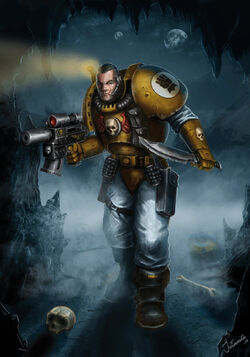
Imperial Fists' Neophyte Scout undergoing his final trials
Being a space-borne Chapter, the Imperial Fists recruit from a variety of worlds, including Terra and Necromunda. The Chapter maintains a great number of Fortress-Chapels on planets across the Imperium. Such places are staffed by small, dedicated cadres of Veterans, perhaps Imperial Fists warriors wounded so grievously they can no longer fight, but are still well able to serve their Chapter. However, the Imperial Fists have no special political rights on the worlds where they recruit their Neophytes as other Chapters do. The staff of these facilities keep a watch upon the peoples around them, seeking potential candidates for recruitment. On some worlds they hold tournaments and contests to ascertain suitability, while on others they actually instigate combat in order to test potential recruits in person. On some Hive Worlds, the Imperial Fists conduct purges of the down-hive slums, ostensibly to clear out undesirable elements on behalf of the planetary government, but they often return with captives they have judged such worthy fighters they will be invited to undertake the trials to become a Neophyte of the Chapter.
The Imperial Fists are unusual in making few, if any, demands of the peoples of the worlds they recruit from, other than the right to test those who believe themselves worthy of entering the ranks of the Battle-Brothers. Whatever the source of the recruit, whether he comes from a brotherhood of warrior-knights or a band of hive-gang psychopaths, the Chapter instils its noble doctrines in him, retaining his essential martial qualities but overlaying them with the qualities that the Imperial Fists have inherited from their Primarch and their ancestors. The Chapter is not especially shaped by the mores and character of the worlds its warriors are drawn form, and instead draws heavily on its own traditions and the values instilled in it by its Primarch.
Once Imperial Fists Aspirants are selected, their criminal record is examined, and they undergo a battery of tests determined to measure their musculature, psychological profile ("psychosis level"), psychic level, eye reflexes, intelligence, the ability to shoot, pain resistance, and dexterity. Recruits spend six months in the Phalanx where they learn proper Imperial Low Gothic through the use of a hypnocasque before undergoing their initiation in the "tunnel of terror." In the latter, they face extreme heat, cold, empty space, etc. The severity of the trial increases along the way. If the Aspirant passes, he becomes a Neophyte cadet and the symbol of the Imperial Fists is tattooed on his buttock. Then begins the psycho-indoctrination, training and the actual surgery and implantation of the gene-seed organs that will make the Neophytes into true Astartes. To celebrate the introduction of the Preomnor implant, cadets eat poisonous plants, venomous animals, etc. For the Omophagea, they consume meat and must divine from the meat a few details about the nature of the actual animal. After the initiation ceremony, the Neophyte's family is informed that their child has become a Space Marine in service to the Emperor so that they may rejoice at their offspring's great fortune.
Deathwatch Service
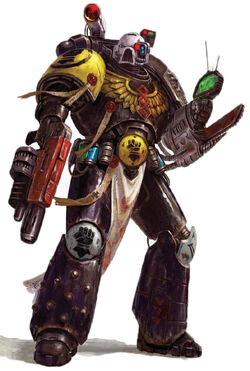
Imperial Fists Deathwatch Apothecary

Imperial Fists Deathwatch Devastator Marine
The Imperial Fists as a Chapter might have largely withdrawn from the Jericho Reach, but they are well represented in the ranks of the Deathwatch. The Sons of Dorn are known to have contributed Battle-Brothers to the Deathwatch since its earliest days, and given the Chapter’s reputation and character it is hardly surprising that this should be so. Many of those standing their Vigil at Watch Station Erioch took the Apocryphon Oath as their Chapter began redeploying to other warzones, choosing to remain and complete the obligations that had brought the Imperial Fists to the region in the first instance.
One such individual is Chaplain Magno Stoan, who served as a Chaplain to the Imperial Fists' 3rd Company for the best part of two standard centuries before the deployment of five of its squads to the Jericho Reach in 801.M41. Chaplain Stoan was present at numerous great victories, including the fall of Fort Crimson, the breaching of the 48th Parallel, and was instrumental in the destruction of the Space Hulk Scion of Vehemence. It was during a mission into the Slinnar Drift that Chaplain Stoan encountered a new and deadly foe—the Dark Eldar. Despite the ferocity of the Imperial Fists’ defence, they found themselves surrounded and impossibly far from any hope of reinforcement. The details of the battle are known only to Chaplain Stoan himself, for no others survive to describe it. Stoan has vowed to keep his own counsel on the matter, but it is known that he was taken alive, having been struck by dozens upon dozens of toxic projectiles, his superhuman constitution finally overcome by the xenos poisons. Dragged back to the Dark Eldar’s fell demesnes, Stoan was tortured and prepared to fight in the gladiatorial arenas of a Wych Cult for the entertainment of the bloodthirsty masses. Though he has never recounted how, Chaplain Stoan not only resisted the tortures his captives inflicted upon his flesh, wounds he still bears the scars of to this day, but he broke his bonds and escaped, capturing one of his tormentors in the process. At length, Stoan made it back to the Jericho Reach, his captive in tow.
Making straight for Watch Station Erioch, Chaplain Stoan presented his prize to the Deathwatch and declared that he would take the Apocryphon Oath. This he did, and while the captive withered and died within a matter of weeks, Stoan and the Deathwatch learned much from the sadistic Dark Eldar before it met its end. The Chaplain stands his Vigil to this day, ministering to the spiritual needs of his Battle-Brothers, regardless of which Chapter they hail from. It is also said that he harbours a special hatred for the Dark Eldar, and that he has tutored numerous brethren in the mental and spiritual disciplines required to resist their torments. This is perhaps Chaplain Stoan and the Imperial Fists’ greatest legacy to the Deathwatch, for thanks to the suffering of one man, all are ultimately made stronger.
Chapter Gene-Seed

The Imperial Fists 2nd Company in combat
The Imperial Fists' gene-seed is very stable and has never exhibited signs of mutation. However, over time they have lost the use of two of the special organs produced by the basic Astartes genetic template: the Betcher's Gland, which allows a Space Marine to produce poisonous/acidic spittle, and the Sus-an Membrane, which allows an Astartes to enter a state of suspended animation.
Another peculiar and unexplained quirk of the Chapter is the Imperial Fists' pathological need to scrimshaw the bones of their dead when off-duty. Scrimshaw is considered a solemn undertaking to the Astartes of this Chapter. It is seen as a way to practice mental discipline, focus, and attention to detail. Oftentimes the finished scrimshaws are worn as jewelry and ornamentation, particularly by the Chapter's officers. None know the roots of this practice, which for many Imperial Fists becomes an obsession they must indulge every hour they are not fighting or training. The bones of slain kin are engraved in minute detail, every surface lovingly covered in lines of devotional script and illuminated scenes depicting the deeds of the fallen. Even the bones of the Chapter's Primarch have been engraved in this manner, preserved as the most sacred relic the Chapter possesses.
The only worrying trait that has attracted scrutiny is the Imperial Fists' over-zealous self-castigation. They often make use of a device called the "Pain Glove", which encases the whole body and stimulates its pain neurons. The Imperial Fists constantly feel the need to punish themselves for the smallest inadequacy, failure or infraction. The last remaining relic of Rogal Dorn, his skeletal hand, is displayed in their fortress-monastery on the Phalanx as a reminder of the ultimate dedication to their duty and the Emperor required of the Space Marines. Considering the circumstances of Rogal Dorn's eventual death, it is clear that the Imperial Fists have a drive for self-sacrifice that they must continually battle to overcome.

Imperial Fist's Veterans fight Valiantly Against their Traitor chaos Brethren.
Although the Imperial Fists have a preference for long-range engagement and specialise in siege warfare, they are also well-known for their passion for dueling, a tradition thought to date back to the earliest days of the old Legion, before it even left Terra on the Great Crusade. The Imperial Fists engage in ceaseless duels against one another, sometimes to settle a point of honour but more often to test themselves and their swordsmanship. The most experienced and long-serving Imperial Fists sport numerous duelling scars all over their bodies, each a reminder of a hard-won victory, or a salutary defeat.
Notable Imperial Fists
- Rogal Dorn - Rogal Dorn was the Primarch of the Imperial Fists Legion and one of the greatest heroes in the history of the Imperium of Man. Dorn constructed the defences of the Imperial Palace in the Himalayan Mountains on Terra that would be sorely tested by the Forces of Chaos during the climax of the Horus Heresy, the terrible Battle of Terra. He is presumed to be deceased after leading an assault against a Chaotic flagship during the 1st Black Crusade. His supposed remains are now sacred relics of the Chapter kept aboard their mighty Chaptership Phalanx.
- Chapter Master Vorn Hagen - Vorn Hagen is the current Chapter Master of the Imperial Fists following the death of Vladimir Pugh in 970.M41, when he was slain battling Tyranids deep within a crashed Space Hulk during the Infestation of Drashin. Captain Darnath Lysander of the 1st Company was initially elected to lead the Chapter, but refused the honour. Instead Capatain Vorn Hagen, the commander of the 5th Company, became the Imperial Fists' new Chapter Master.
- Chapter Master Vladimir Pugh - Vladimir Pugh was the predecessor of Chapter Master Vorn Hagen. Whilst not a particularly inspirational leader, Pugh was considered as meticulous a planner as any Chapter Master in the Imperial Fists' history. Pugh was slain battling Tyranids deep within a crashed Space Hulk during the Infestation of Drashin in 970.M41.
- Chapter Master Lazerian - Chapter Master of the Imperial Fists during the Age of Apostasy in the 36th Millennium and present during the Second Siege of the Imperial Palace where the Black Templars, Imperial Fists, Soul Drinkers and Fire Hawks fought to depose the insane High Lord Goge Vandire.
- Chapter Master Bronwin Abermort - One of the Imperial Fists' early Chapter Masters.
- Chapter Master Maximus Thane - One of the Imperial Fists' early Chapter Masters.
- Chapter Master Kalman Flodensbog - One of the Imperial Fists' early Chapter Masters.
- Chapter Master Ambrosian Spactor - One of the Imperial Fists' early Chapter Masters.
- First Captain Sigismund - Sigismund was the First Captain of the Imperial Fists Legion during the Great Crusade and the Horus Heresy. Sigismund was a name that echoed through the Great Crusade even before the darkness of the Horus Heresy made him the stuff of legends. Born on Terra and raised to the Legiones Astartes as the Great Crusade was at its height, he ascended in rank and renown thanks to a simple fact: he was a warrior of unparalleled lethality and ability. Beneath the Primarchs there has perhaps never been a more skilled warrior in combat. Across the battlefields of hundreds of worlds and the duelling floors of every Legion, he was never defeated. The fire of the Crusader always burned brightly in him and if one warrior could embody the Great Crusade's spirit of noble conquest it was Sigismund. Those who faced him in the circle of blades, or stood beside him in battle, speak of a fury shackled by an iron will and an inherent genius for dealing death that bordered on the supernatural. It was his skill and fire that brought Sigismund to command the Templars of the legion's 1st Company, and the most exalted position in the Imperial Fists beneath Rogal Dorn himself. Following the tragic events of the Heresy, the Space Marine Legions were broken down into smaller Chapters. Sigismund would go on to lead the more zealous elements of the Imperial Fists and was elevated to the esteemed rank of High Marshal (Chapter Master) of the newly formed Black Templars Chapter.
- Captain Camba-Diaz - During the Horus Heresy era, Camba-Diaz was the Second Captain of the Imperial Fists Legion. Due to his fighting prowess and ability to stay cool under fire, Primarch Dorn often deployed Captain Camba-Diaz beside First Captain Sigismund. The resolute and taciturn Captain was a soothing balm to Sigismund's fiery temper. They complemented one another in battle. During the Horus Heresy Camba-Diaz played an instrumental role in the vital mission to obtain armour and munitions from the forges on Mars during the great civil war known as the Schism of Mars which had erupted between the Loyalist Mechanicum and Dark Mechanicus forces.
- Captain Efried - Efried was the Third Captain of the Imperial Fists Legion during the Horus Heresy. Captain Efried served as adjutant to Rogal Dorn during the fortification of the Emperor's Imperial Palace. Captain Efried had previously served alongside the Luna Wolves' 3rd Company in the Great Crusade during a year-long Imperial Compliance campaign. With the outbreak of the Horus Heresy, Captains Efried and Halbrecht served alongside Primiarch Dorn during the early days of the fortification of the Imperial Palace and the preparation of Terra and the entire Sol System for the invasion of the Traitor Legions of Horus.
- Captain Amandus Tyr - Captain Tyr was the Sixth Captain of the Imperial Fists Legion during the Great Crusade and the Horus Heresy. The 2nd Assault Echelon of the 6th Company was amongst the first of the Imperial Fists Legion to be issued with Cataphractii Pattern Terminator Armour, as its members were masters in a range of heavy assault doctrines. At the Battle of Phall, all of the Leigon's Tactical Dreadnought Armour-equipped warriors were gathered into a single body and gathered under the command of Captain Tyr. When Tyr led the attack against the Iron Warriors warship Iron Blood in a desperate mission to slay the Primarch Perturabo, the 2nd Assault Echelon went into battle at his side. Practically nothing is known of the attack, for contact was all but impossible once it was underway, meaning those brave souls counted amongst its ranks could not be recalled when the remainder of the Imperial Fists fleet disengaged from the Iron Warriors in the final stages of the Battle of Phall.
- Captain Alexis Polux - Alexis Polux was the Captain of the 405th Company of the Imperial Fists Legion during the Great Crusade and the Horus Heresy in the 30th and early 31st Millennia. Polux was a warrior of unique promise both elevated to greatness and condemned to bear great sorrow by the events of the Horus Heresy. A tactical genius with a talent for void warfare, he was the protégée of the Legion's greatest fleet masters, although before the dark betrayal of the Warmaster Horus, he was yet to reach his full potential. Inwit-born, he was a physical giant even among his brothers of the Legion, and of a character as if cast in stone, emotionless and unyielding, whose reputation before the Battle of Phall rested as much on his strength in the bloody melee of close quarters combat as in command. When Primarch Rogal Dorn sent his Retribution Fleet to aid the beleaguered Loyalists on Istvaan III, Polux would likely still have had many years of proving ahead of him before he attained high command, but cruel chance and the death of his mentors saw such command thrust upon him, and with it the fate of much of his Legion lay in his hands. Polux went on to win Dorn's respect countless times during the dark days of the Great Betrayal. Following the events of the Heresy, the Space Marine Legions were broken down into smaller Chapters, and Polux was selected to lead the newly formed Crimson Fists Chapter. He went on to lead the Crimson Fists for the first 800 standard years of their existence. During this time, he did much to shape their interpretation of the Codex Astartes and their combat doctrines.
- Captain Fafnir Rann - Rann was a ruthless and bellicose Captain of the Imperial Fists Legion during the Great Crusade and the Horus Heresy. By the opening days of the Heresy, Rann had risen to the esteemed rank of Seneschal. When Rogal Dorn mustered the Retribution Fleet to be sent to assist the beleaguered Loyalists on Istvaan III, Rann's Chapter was selected along with a third of the Legion. During the Battle of Phall, Rann's Chapter participated in the Blade of Perdition's hit and run action against the Iron Warriors Heavy Cruiser Sire of Sabaktes, teleporting into the warship's central armoury and planting a Melta charge that, when it detonated, set off a chain reaction and destroyed the entire vessel and its crew. By the time the survivors returned to the Blade of Perdition, Fleet Master Alexis Polux had issued the order to withdraw and it was characteristic of Seneschal Rann and his warriors that the Blade was one of the very last to obey. Following the tragic events of the Great Betrayal, the Space Marine Legions were broken down into smaller Chapters, each with their own unique name, heraldry and traditions, with the originating Primogentor retaining the original name and heraldry. Rann would continue to serve in the Imperial Fists Chapter until the Third Founding which occurred in 001.M32. Rann was selected to become the patriarch and first High Executioner (Chapter Master) of the newly founded Executioners Chapter.
- Captain Aleph - Aleph was a Captain of the Imperial Fists who was present during the defence of the Emperor's Imperial Palace on Terra at the climax of the Horus Heresy. He was the ancestral source of the gene-seed used in the transformation of Captain Demetros in the 41st Millennium, and was eventually slain by the Black Legion's Captain Scaevolla, a former comrade-in-arms of Aleph. Scaevolla allowed Aleph's Progenoid Glands to be recovered by the Imperial Fists, however, so that another would inherit Aleph's genetic legacy. The Black Legion Captain would then one day face this new recipient of Aleph's genetic legacy, thus starting the cycle of confrontation and death all over again.
- Captain Halbrecht - Halbrecht was a Captain of the Imperial Fists Legion who served during the Horus Heresy. Along with Captain Efried, Halbrecht was the only other captain of his Legion to accompany Rogal Dorn to Terra with former Death Guard Battle-Captain Nathaniel Garro and his heroic 70 Astartes survivors of the virus-bombing of Istvaan III. The rest of the Legion went to investigate Istvaan before returning to Terra. In the meantime, Halbrecht and Efried served Dorn during the early days of the fortification of the Imperial Palace and the preparation of Terra and the entire Sol System for the invasion of the Traitor Legions of Horus.
- Captain Learchus - Learchus was an Imperial Fists Captain who served with the Legion during the Great Crusade and Horus Heresy eras. He was present at the defence of the Emperor's Imperial Palace during the Battle of Terra, and was killed fighting against Death Guard Plague Marines.
- Captain of the Banner Navarre - Navarre was the Emperor's Champion of the Black Templars Chapter who carried the Chapter Banner across the breach in the walls of the Imperial Palace during the height of the fighting during the Second Siege of the Imperial Palace in the 36th Millennium. For his actions, he was granted the honorary title "Captain of the Banner" within the Imperial Fists Chapter by the Imperial Fists' Chapter Master Lazerian.
- Captain Darnath Lysander - Darnath Lysander is the Captain of the 1st Company, Overseer of the Armoury and Watch Commander of the Phalanx. The famous Imperial Fist Captain first appeared in the Liber Honorus Imperial Fists in 567.M40 as a Sergeant in command of a unit of the 2nd Company where he was victorious over a group of Heretics on Iduno at the Battle of Colonial Bridge. He was then promoted to command of the 2nd Company in 585.M40 after successfully boarding and capturing an Eldar Cruiser. During the three year siege of the world of Haddrake Tor to retake it from the Forces of Chaos, Lysander witnessed the death of the Captain of the 1st Company, Kleitus, and from him received the Imperial Fists' sacred relic Thunder Hammer, the Fist of Dorn, which he used to go on and conquer the Heretics. Lysander was soon after promoted to command the elite 1st Company, which he led for many years. Whilst leading a force of Imperial Fists, they disappeared into a Warp Storm and were feared lost, though the Chapter patiently waited for his return for quite some time. The Chapter ultimately pronounced Lysander and his men dead in absentia. In truth, Lysander's starship re-emerged into Chaos-held space where it was captured by the Imperial Fists' bitter enemies, the Iron Warriors. Lysander and the survivors were captured and taken by the Traitors to one of their accursed Fortress Worlds, known as Malodrax, and were tortured for years. Eventually Lysander, without weapons or armour, effected his escape and fought his way off the accursed Chaos world to freedom. When he returned to the Imperial Fists Chapter, many centuries had passed in the material universe. Fearing that he might have been tainted by the Ruinous Powers, Lysander was thoroughly screened by the Chapter's various specialists and found free of Chaotic taint. Afterwards, Captain Lysander was reinstated to his position as Captain of the 1st Company. Lysander then lead a force to raze the Iron Warriors from Malodrax and laid the world to waste, achieving his vengeance at last.
- Captain Taelos - Taelos was the Captain of the 10th Company, and the former Captain of the 2nd Company. Whilst in command of the 2nd Company, Captain Taelos played a vital role against the Tau's expansion during the Nimbosa Crusade. The contested planet of Nimbosa on the outskirts of the Tau Empire had been fought over several times before and the Imperial forces there were stretched to the brink of collapse. Captain Taelos and Imperial Ambassador Palmatus traveled to the Tau world of T'olku in an attempt to stall the Tau invasion. They were unsuccessful, but with the arrival of the Black Templars, Ultramarines, Raven Guard and several other Astartes Chapters, the tide quickly turned and the Tau were driven from the world without mercy. The Black Templars established a Chapter keep on the world. Elements from the 2nd Company were present during the Koloth Gorge Massacre, where Commander Brightsword of the Tau Empire ambushed and slaughtered an entire regiment of Imperial Guard and many of the Imperial Fists present. Captain Taelos himself was severely wounded and following the massacre, Taelos was incapacitated for the rest of the campaign and another took his place to command the 2nd Company. After the campaign, Captain Taelos sought leave to go on a Warrior Pilgrimage, a lone trip across the Imperium to fight the enemies of the Emperor alone until death claimed him, to atone for the loss of so many Space Marines under his command, but Chapter Master Pugh refused and instead appointed Taelos to command of the 10th Company. It was Captain Taelos himself who recruited s'Tonan, du'Queste and Zatori and watched them rise through training and their trial as Scout Marines to become full Battle-Brothers.
- Captain Alaric Eshara - Eshara is the Captain of the Imperial Fists' 3rd Company. Eshara led his company against the Iron Warriors on the planet of Hydra Cordatus. Unbeknownst to the defenders, the world of Hydra Cordatus was one of two large storage facilities for their tithes of Space Marine gene-seed possessed by the Adeptus Mechanicus. The genetic material at these centres was used to test all active Chapters for genetic purity and to create new Chapters during a Founding. While the defenders fought with faith and skill they were ultimately defeated in the end, and most of the gene-seed was captured by the Traitors. The Imperial Fists fought to the last and Eshara himself was cut down by the ascendant Iron Warriors Warsmith who became a powerful Daemon Prince of Chaos following this victory.
- Lexandro D'Arquebus - Former Captain of the Imperial Fists. A high-habitat resident of the Trazior Hive on Necromunda before his recruitment into the Imperial Fists, Lexandro rose rapidly through the ranks of the Imperial Fists. He is the only surviving one of the "Three Brothers" of Trazior; the finger bones of his left hand are inscribed with the names of his two deceased Battle-Brothers from the hive city of Trazior as a permanent memorial to them. He is one of the main characters of Ian Watson's recently re-released non-canon 1993 novel Space Marine, and also appears in his Inquisition War trilogy.
- Deathwatch Captain Bannon - Captain Bannon was the Imperial Fists Astartes who served as the leader of the Deathwatch Kill-team present during the defence of the world of Tarsis Ultra, tasked with assisting Inquisitor Kryptman in fighting the Tyranids. Bannon and his team aided the defences alongside the Space Marines of the Mortifactors and Ultramarines Chapters, though Bannon himself and half of his team died during the course of the events on Tarsis Ultra. Their death was not in vain, however, as the Tyranids were eventually fought off after the death of one of their Norn-Queens.
- Deathwatch Captain Octavius - Captain Octavius was the Imperial Fists Astartes who led a Deathwatch Kill-team that included three individuals seconded temporarily from the Mantis Warriors Space Marine Chapter. These Astartes, previously disgraced due to their actions during the Badab War, proved their honour with the Deathwatch following a series of heroic actions and sacrifices. After his actions on Herodian IV, Captain Octavius was given the rare honour of remaining seconded by his Chapter to the Deathwatch permanently. However, his tenure was cut short when he fell in battle against a Dark Eldar Talos Pain Engine. One shoulder plate from his armour was all that was recovered by his team, though their mission was accomplished and no other members fell in battle. The team managed to escape their Dark Eldar captors and reach their grounded Thunderhawk gunship.
- Archamus - Never so volatile as First Captain Sigismund, Archamus was the master of Rogal Dorn's Honour Guard retinue known as the Huscarls during the Great Crusade and Horus Heresy eras.
- Instructional Officer Rhetoricus - A legendary figure within the Imperial Fists Chapter, Rhetoricus was a contemporary of Chapter Master Vladimir Pugh and the author of The Book of Five Spheres. In his later years, after his injuries placed him in a hover chair and rendered him unable to serve in the field, Rhetoricus was involved in instruction of Imperial Fists Neophytes during training and implantation of their gene-seed.
- Lo Chang - Lo Chang is the moon-faced Chaplain that serves as his Chapter's Master of Sanctity and Reclusiarch. He has a countenance that is badly scarred by crater-like wounds incurred when his helmet failed him in combat. When Lo Chang preaches, he is swept up in devout ecstasy wherein his passion can inspire any Imperial Fists Space Marine to strive to be a true child of Rogal Dorn and servant of the Emperor of Mankind. Lo Chang appeared in the recently re-released non-canon novel Space Marine by Ian Watson.
- Carnark - Chaplain Carnak was the Keeper of the Shrine of Mithron for centuries, having served the Chapter for more than four hundred standard years. Chaplain Carnak and his assistant Brother Nidon were the only survivors of the Shrine Guard stationed on the planet, as the rest of the Imperial Fists' 5th Company was wiped out by a force of Chaos Space Marines. Chaplain Carnak was killed by the possessed body of Ultramarines Captain Severus aboard the 2nd Company's Strike Cruiser in orbit over Mithron, the daemon within Severus executing Carnak before he could reveal Severus' possession to the other Space Marines present.
- Dominicus - Chaplain Dominicus was attached to the Imperial Fists' 10th Company during its recent recruiting mission aboard the Strike Cruiser Capulus. Dominicus is a stern but inspiring man, charged with first introducing Initiates to the Chapter to the Pain Glove, and instructing them in the Imperial Fists' Cult of Dorn.
- Magno Stoan - Magno Stoan served as a Chaplain to the Imperial Fists' 3rd Company for the best part of two standard centuries before the deployment of five of its squads to the Jericho Reach in 801.M41. Chaplain Stoan was present at numerous great victories, including the fall of Fort Crimson, the breaching of the 48th Parallel, and was instrumental in the destruction of the Space Hulk Scion of Vehemence. It was during a mission into the Slinnar Drift that Chaplain Stoan encountered a new and deadly foe—the Dark Eldar. Despite the ferocity of the Imperial Fists’ defence, they found themselves surrounded and impossibly far from any hope of reinforcement. The details of the battle are known only to Chaplain Stoan himself, for no others survive to describe it. Stoan has vowed to keep his own counsel on the matter, but it is known that he was taken alive, having been struck by dozens upon dozens of toxic projectiles, his superhuman constitution finally overcome by the xenos poisons. Dragged back to the Dark Eldar’s fell demesnes, Stoan was tortured and prepared to fight in the gladiatorial arenas of a Wych Cult for the entertainment of the bloodthirsty masses. Though he has never recounted how, Chaplain Stoan not only resisted the tortures his captives inflicted upon his flesh, wounds he still bears the scars of to this day, but he broke his bonds and escaped, capturing one of his tormentors in the process. At length, Stoan made it back to the Jericho Reach, his captive in tow. Making straight for Watch Station Erioch, Chaplain Stoan presented his prize to the Deathwatch and declared that he would take the Apocryphon Oath. This he did, and while the captive withered and died within a matter of weeks, Stoan and the Deathwatch learned much from the sadistic Dark Eldar before it met its end. The Chaplain stands his Vigil to this day, ministering to the spiritual needs of his Battle-Brothers, regardless of which Chapter they hail from. It is also said that he harbours a special hatred for the Dark Eldar, and that he has tutored numerous brethren in the mental and spiritual disciplines required to resist their torments.
- Akrida - Akrida is a Chaplain of the Imperial Fists who served during the Great Crusade and Horus Heresy eras. He was present at the defence of the Imperial Palace during the Battle of Terra.
- Borgos - Borgos is a Chapter Librarian who holds the rank of Epistolary. He was attached to the 10th Company during its recent recruiting mission aboard the Strike Cruiser Capulus. Though Borgos is physically blind, he refuses augmetic implants. This is because his blindness does not hinder him in the slightest as his Warp sight is far superior to whatever mortal sight might provide him.
- Corwin - Corwin was a Librarian attatched to the Imperial Fists 3rd Company under Captain Eshara during the relief of beleaguered Imperial forces on the world of Hydra Cordatus which was under siege by a large warband of Iron Warriors Chaos Space Marines. Corwin sacrificed himself to open a portal through the Warp to allow a horrific Greater Daemon of Khorne to leave the fighting on Hydra Cordatus and hopefully spare his comrades from death at its hands. Where the daemon went or the result of this action on Corwin's soul are unknown, but his valiant sacrifice did buy the Imperial defenders some time, though in the end the battle was still lost.
- Franz Grenstein - The Imperial Fists Librarian Franz Grenstein is described as dusky-skinned, with criss-crossed duelling scars on both cheeks from numerous honour duels. An intense and preoccupied Imperial Fists Librarian, Grenstein takes his responsibilities to keep the Imperial Fists safe from psychic or daemonic enemies very seriously. On the rare occasions an Imperial Fists Space Marine is in contact with Chaos, it is Grenstein who will be assigned to help them regain their mental stability and ensure they have not brought Chaos's taint with them. Grenzstein was killed during a search-and-destroy mission against Tyranids; he appeared in the recently re-released non-canonical novel Space Marine by Ian Watson.
- Lysol Blane - In 812.M39, Techmarine Blane wrote the Liber Proditor Armorum, a text containing his insight into the use of armoured units by the Traitor Legions. The Liber was set to be an approved addition to the sacred Codex Astartes when its inclusion was blocked for unknown reasons by the Iron Hands Space Marine Chapter.
- Brother Szobczak - Szobczak is an ancient and cantankerous Deathwatch Dreadnought formerly of the Imperial Fists 5th Company. Inducted into the Chapter in the late 34th Millennium, he served with distinction. Eventually he became a Techmarine and was attached to the 5th Company, distinguishing himself as both a gifted siege engineer and tech-priest. For nearly two centuries he served the 5th Company. In early M35, Brother Szobczak was seconded to the Deathwatch at a long-lost Watch Station in the galactic East of Ultima Segmentum. At the end of his vigil, he petitioned to be allowed another, feeling that his work was far from complete. He was granted his request and completed three more vigils, acting as an infiltrator and sapper, until he was grievously wounded in a campaign supporting the Imperial Guard against an Ork Waaagh! His wisdom and unique skill-set were deemed to valuable to waste, and so, the Deathwatch honoured him by interring him within the Adamantium sarcophagus of a Dreadnought. Though he can remember his early days with the Imperial Fists and his first Vigils with the Deathwatch, he remembers little to nothing about his time as a Dreadnought. Records at Watch Fortress Erioch mention no Imperial Fists matching his name or description, nor is he listed amongst the Battle-Brothers slumbering in the Watch Fortress's Chamber of Elders where the few Dreadnoughts officially attached to the Deathwatch are kept.
- Scout Sergeant Zed Juron - Juron was the first Astartes squad leader to have Tundrish, d'Arquebus and Valance under his command. Juron led the Scout Marines during the Karkasson Campaign where the squad, code-named the "Wolverines," performed spectacularly. He orchestrated the capture and control of an Imperator-class Titan on that rebel-held world and took the throne of the Princeps during the battle. Later, he led a squad of Battle-Brothers under the command of Lieutenant Vonreuter in one of the Imperium's first boarding actions against a Tyranid Hive Fleet.
Chapter Relics
"If you bear the honour and glories of the past, you must also bear its duties."
- — Danarth Lysander, Imperial Fists Captain
- Armour of Dorn - Fragments of Dorn's golden Artificer Power Armour are kept by the Second Founding Black Templars Chapter.
- Dorn's Skeletal Hand - The now skeletal hand of the Primarch Rogal Dorn recovered from the Chaotic warship known as the Sword of Sacrilege duing the 1st Black Crusade is one of the Imperial Fists' most sacred relics and is kept in stasis in the innermost chapels of the Phalanx. Each Chapter Master writes his name in minute script on the bones of the hand, a symbolic reminder of the Chapter Master's duty to the Primarch. When Rogal Dorn was still alive he and any new Chapter Master would slit their palms and clasp hands, the sacred blood of the Primarch mixing with that of the new Chapter Master. A symbolic and physical representation of the duty and responsibility of the new Master of the Chapter towards the Astartes of one of the Imperial Fists' Successor Chapters. With Dorn's death, the ceremony has ceased but by inscribing the names of its Chapter Masters on the bones of Dorn's hand the Chapter honours the memory of its bond with the Imperial Fists' progenitor.
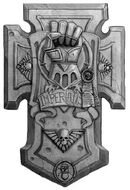
Duty's End
- Duty's End - Duty's End is a powerful relic Storm Shield. Brother Sergeant Artor and his squad were posted on the world of Deepcut IX, guarding a mine colony, when Ork raiders attacked. Despite assurances of assistance from the hundred or so miners, their chief foreman convinced them to flee and hide deep in the tunnels. The ten Space Marines were left to defend the mine head unaided against a horde of nearly a thousand Orks. The mine entrance was an excellent place to defend, but inevitably the Ork numbers overwhelmed the Imperial Fists. Artor was last to fall, countless Slugga shells impacting on his great Storm Shield as he hacked down Greenskin after Greenskin.

The Fist of Dorn
- The Fist of Dorn - The Fist of Dorn is a legendary master-crafted Thunder Hammer traditionally wielded by the Captain of the Imperial Fists' 1st Company. The weapon is shaped to resemble a gauntleted fist that is holding each end of the warhammer's head. The arcane technologies built into the Fist of Dorn allows it to strike with far more powerful blows than that of a normal Thunder Hammer, and was designed to be most effective when used to assault heavily armoured vehicles and fortifications. It is currently carried into battle by Captain Darnath Lysander, who received it from his predecessor Kleitus when the latter was killed in a teleportation accident during the siege of Haddrake Tor.
- Icon of the Iron Cage - Legend says that in memory of the Imperial Fists’ great battle against the Iron Warriors Traitor Legion and their rebirth as a Chapter, a handful of survivors of that time crafted Icons of the Iron Cage. No one knows if these stories are true. However, there are a few talismans used by the Imperial Fists in the Jericho Reach Deathwatch that bear a resemblance. Whether or not they are the very same Icons crafted millennia ago there is no way of telling, but their inspiring effects on the Battle-Brothers that wear them cannot be denied. Named for the infamous siege of the Imperial Fists against the Iron Warriors Traitor Legion, the Icon is a talisman worn on Power Armour that reminds the Battle-Brother of the strength of faith and unity his Chapter displayed against the Traitor Legions, and how that strength still flows through his Chapter today.
- Ossific Relic - Many Imperial Fists bear small tokens of lost Battle-Brothers, engraving their bones with descriptions of their deeds so that they may never be forgotten and will live on forever. Ossific Relics take the form of small bones, normally finger or hand bones, carried in a small pouch near the Battle-Brother's heart, or sometimes on a chain around his neck or wrist. Far from grisly or barbaric, this practice is the ultimate act of remembrance for an Imperial Fist, and the relic of his fallen brethren are his most valued possessions.
- Pain Glove - A tool of both torture and penitence, the Pain Glove is a cage of ancient technology and cunning design that the Imperial Fists have used for centuries to test their strength, punish the unworthy, and cleanse themselves of sins, weakness and guilt.
- Roma - The Roma was the first Imperial battle honour won by the VII Legion at the start of the Great Crusade in the late 30th Millennium. The honour exists now only as a Ceramite icon, as it is too precious to be displayed in even the most heavily protected Inner Reclusium aboard the Phalanx.
- Scrimshaw Tools - It is said that as an Imperial Fist grows older and sees more of his Battle-Brothers fall in combat, his urge to master the practice of scrimshawing the bones of his fallen kin becomes all but irresistible. Often, this devotional act serves to belay any sense of failure the Battle-Brother may feel for his own part in the death, whether real or imagined, and in some cases is an act of penance imposed by the Chapter Chaplains or by the Imperial Fist himself.
- Soulspear - The Soulspear was an ancient Chapter relic wielded by the Primarch Rogal Dorn during the Great Crusade. It was forged from lost archeotech by the hand of the Emperor Himself, and gifted to His son. In battle it acted as a Warp vortex weapon, able to cut through anything. This sacred artefact was entrusted to the Imperial Fists' Successor Chapter, the Soul Drinkers, when the Legion was split during the Second Founding. The spear was lost for over ten thousand years before the Chapter discovered its whereabouts on an old derelict starfort. Upon destroying the starfort's defenders, the Soul Drinkers made their way to a treasure room in which the Soulspear was kept, where it was then stolen from their grasps by the Adeptus Mechanicus. In their obsessive need to obtain this sacred relic, the ensuing crisis resulted in a chain of events that saw the Soul Drinkers' declared Excommunicate Traitoris by the Inquisition. The Soul Drinkers eventually recovered the Soulspear, which was used by their Chapter Master Sarpedon to slay a Greater Daemon of Tzeentch named Abraxes.
- Strikers of Allerox - These heavy gauntlets were worn by Captain Allerox in the purging of Hive Greyreach. The hive was infested by daemons who had slaughtered nearly half of the workforce populace. Allerox himself strangled the daemonic Herald of Khorne who had led the bloody rampage.
- The Sword of Dorn - The blade carried by Rogal Dorn was shattered when Dorn broke it over his knee after returning from Horus' flagship Vengeful Spirit with the broken body of the Emperor at the end of the Battle of Terra. Dorn vowed never to wield the blade again as a penance for his failure to protect the Emperor. First Captain Sigismund kept the shattered blade and had part of it forged into the weapon known as the Sword of the High Marshals that is a relic of the Black Templars Chapter, as a reminder of the duty and sacrifice expected of the Sons of Dorn. The broken blade resides in the halls of the Eternal Crusader, the Battle Barge and flagship of the Black Templar Crusade Fleet.
- Liber Mithrus - The Liber Mithrus was an ancient tome of knowledge granted to the Imperial Fists Legion at its Founding by the Emperor of Mankind Himself. The Imperial Fists Chapter later inherited the artefact after the Second Founding and held it as a sacred relic, placing it in a special shrine erected on the desolate Shrine World of Mithron. There it was protected by a perpetual honour guard composed of an entire company of Space Marines drawn from the Imperial Fists. During an incursion by the Forces of Chaos led by the Chaos Space Marines of the Black Legion, the book was nearly captured until the surviving Imperial Fists were aided by the arrival of the Ultramarines 2nd Company's Ultima Squad. Unfortunately, a daemon possessed the commander of the 2nd Company, Captain Severus, after the Ultramarines recovered the Liber Mithrus from its shrine. The daemon intended to use the arcane knowledge contained within the tome to open a Warp portal on the Ultramarines homeworld of Macragge and unleash its daemonic brethren upon that bastion of the Imperium. The daemon was defeated by Battle-Brother Proteus within the Reclusium of the 2nd Company's Battle-Barge by wielding the sacred Hammer of Macragge. It is unknown if the Liber Mithrus was returned to the Imperial Fists following this incident.
Chapter Fleet
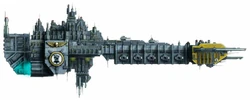
An Imperial Fists Battle Barge
The Imperial Fists' Chapter fleet includes the Gothic-class Cruiser Imperial Power, as well as Cobra-class Destroyers which are used as Escorts. At least three Imperial Fists Strike Cruisers took part in the attack on the Chaos forces located at the Peleon's Belt Heretic anchorage.
Known Imperial Fists vessels within the Chapter fleet include:
- Phalanx (Mobile Fortress-Monastery) - The flagship and mobile fortress-monastery of the Imperial Fists, the Phalanx is like no other warship in the Imperium and has waged war across the galaxy for more than ten thousand standard years, being itself an artefact of the Dark Age of Technology.
- Hammer of Terra (Battle-Barge) - The Hammer of Terra was destroyed in combat during the opening days of the Horus Heresy at the Battle of Phall.
- Spear of Vengeance (Battle-Barge) - One of the oldest and most venerable Battle-Barges within the Imperium which dates back to the glory years of the Great Crusade.
- Storm of Wrath (Battle-Barge) - One of the oldest and most venerable Battle-Barges within the Imperium which dated back to the glory years of the Great Crusade.
- Sword of Terra (Battle-Barge) - Destroyed by the fleet of the Iron Warriors Traitor Legion around the world of Phal during the Horus Heresy.
- Tribune (Battle-Barge) - Temporary flagship of Captain Alexis Polux of the Imperial Fists Retribution Fleet, it was destroyed during the opening days of the Horus Heresy at the Battle of Phall.
- Sulla (Grand Cruisder) - Destroyed during the opening days of the Horus Heresy at the Battle of Phall.
- Capulus (Strike Cruiser) - The Strike Cruiser assigned to Captain Taelos and the 10th Company during its most recent recruitment mission.
- Halcyon (Strike Cruisder) - Destroyed during the opening days of the Horus Heresy at the Battle of Phall.
- Justitia Fides (Strike Cruiser) - Strike Cruiser assigned to the 3rd Company during the disastrous Hydra Cordatus Campaign.
- Shield of Valour (Strike Cruiser) - Strike Cruiser carrying Captain Lysander and a sizeable portion of the 1st Company late in the 40th Millennium that was lost in the Warp for nearly a thousand Terran years before returning near the orbit of the Iron Warriors Fortress World of Malodrax, where the vessel and its Astartes were subsequently captured by the Traitors.
- Terrible Angel (Strike Cruiser) - Strike Cruiser that was fired on by the Imperial Navy following the Horus Heresy for Rogal Dorn's refusal to accept the tenets of the Codex Astartes and the dissolution of the Space Marine Legions into Chapters.
- Titus (Strike Cruiser) - Strike Cruiser that carried Task Force Gauntlet to the Vernalis System. The Titus also earned much renown for its participation in the Gothic War.
- Truth (Strike Cruisder) - Sister ship of the Halcyon, it was also destroyed during the opening days of the Horus Heresy at the Battle of Phall.
- Unity (Strike Cruisder) - Sister ship of the Halcyon, it was also destroyed during the opening days of the Horus Heresy at the Battle of Phall.
- Vengeance Incandescent (Strike Cruiser)
- Veritas (Strike Cruiser) - Destroyed during the opening days of the Horus Heresy at the Battle of Phall.
- Imperial Power (Gothic-class Cruiser)
- Redemption of Fire (Capital Warship, Class Unknown) - Unknown-class warship despatched to Duras III to halt an Ork incursion.
- Crusader (Escort) - Destroyed during the opening days of the Horus Heresy at the Battle of Phall.
- Legate (Escort) - Destroyed during the opening days of the Horus Heresy at the Battle of Phall.
- Lacedaemon (Battleship, Unknown Class) - This vessel had carried the first Imperial Fists beyond the Sol system during the Great Crusade, but met its ultimate fate when it was destroyed during the opening days of the Horus Heresy at the Battle of Phall.
- Oath of Stone (Battleship, Unknown Class) - This vessel was old before it served the Imperium, and it had aged in scars and honours during the Great Crusade. Destroyed during the opening days of the Horus Heresy at the Battle of Phall.
- Endeavour of Will (Imperial Starfort) - The Endeavour of Will was a powerful Starfort with a quasi-sentient Machine Spirit that is used by the Imperial Fists, along with its sister Starfort the Bastion Inviolate, to guard an area of Imperial space around the Eye of Terror. The Endeavour of Will was attacked by an Iron Warriors warband led by the Warsmith Shon'tu in 998.M41, leading to the destruction of the Bastion Inviolate and the narrow defeat of the Warsmith's forces.
- Bastion Inviolate (Imperial Starfort) - The Bastion Inviolate was a Starfort of the Imperial Fists that, along with its sister Starfort the Endeavour of Will, were used to guard a region of Imperial space around the Eye of Terror from the Traitor Legions. The Bastion Inviolate was destroyed during the Battle for the Endeavour of Will in 998.M41.
Chapter Appearance

Imperial Fists 5th Company shoulder plate bearing the markings of the 7th Assault Squad
Chapter Colours
The Imperial Fists' Power Armour is a golden yellow while company is designated by shoulder trim colour in accordance with the Codex Astartes (i.e. 1st Company - White, 2nd Company - Yellow, 3rd Company - Red, 4th Company - Green, etc.). Squad speciality (Tactical, Assault, Devastator or Veteran) is indicated by the standard Codex Astartes-approved iconography in black, and the squad number is designated by a small black Roman numeral placed to either side of the squad speciality icon. The rank of Sergeant is indicated by a red helmet, while Veteran status is displayed by a white stripe painted down the centre of the helmet.
Chapter Badge
The Imperial Fists' Chapter badge is an armoured, grey or black fist on a white or yellow roundel with a grey or black circular border.
Controversial Depiction
Ian Watson's novel Space Marine, the first fictional representation of the Space Marines ever written, revolves around the recruitment, training and combat experiences of an Imperial Fist Astartes. Unfortunately, the content of the book is no longer considered to be canon and in fact the tale has been deemed outright heretical by Imperial authorities.
Sources
- Cities of Death (Supplement)
- Codex: Astartes
- Codex: Black Templars (4th Edition), pp. 6, 19
- Codex: Chaos Space Marines (3rd Edition, 1st Codex), pg. 32
- Codex: City Fight, pp. 74-78
- Codex: Imperialis
- Codex: Space Marines (6th Edition), pp. 8, 40-45, 47, 49, 93, 114, 150-151
- Codex: Space Marines (5th Edition), pp. 8, 27, 31, 45, 49, 91
- Codex: Space Marines (4th Edition), pp. 47, 77, 81
- Codex: Space Marines (3rd Edition)
- Codex: Tau (4th Edition)
- Codex: Ultramarines (2nd Edition)
- Collecting and Painting Wargames Armies
- Deathwatch: Core Rulebook (RPG), pp. 38-39,
- Deathwatch: First Founding (RPG), pp. 54-56, 104
- Deathwatch: Rites of Battle (RPG), pp. 44-51, 53, 66-69, 157
- Epic: Battle Book
- How To Paint Space Marines
- Horus Heresy: Collected Vision, pp. 249, 342-343, 353, 359
- Imperial Armour Volume Two - Space Marines and Forces of the Inquisition, pp. 30, 138, 150, 160
- Imperial Armour Volume Two (Second Edition) - War Machines of the Adeptus Astartes, pg. 18
- Imperial Armour Volume Ten - The Badab War, Part Two, pg. 84
- Imperial Armour - The Horus Heresy - Book One: Betrayal, pp. 80-81
- Index Astartes, Imperial Fists, Games Workshop Website
- Index Astartes II, "Emperor's Fist - The Imperial Fists Space Marine Chapter", pp. 12-17
- Index Astartes IV, "Bloodied Fist - The Crimson Fists Space Marine Chapter"
- Insignium Astartes
- The Art of Clint Langley
- The Thirteenth Black Crusade
- To Cleanse The Stars by Andy Chambers and Matt Keefe
- Warhammer 40,000 Rulebook (6th Edition), pg. 219
- Warhammer 40,000 Rulebook (5th Edition), pg. 142
- Warhammer 40,000: Sentinels of Terra (Imperial Fists Supplement)
- White Dwarf 302 (UK), "Heroes of the Imperium", pp. 84-85
- White Dwarf 286 (UK), "The Eye of Terror", pp. 69-70
- White Dwarf 249 (US), "Index Astartes - Emperor's Shield"
- Horus Rising (Novel) by Dan Abnett
- The Flight of the Eisenstein (Novel) by James Swallow
- Mechanicum (Novel) by Graham McNeill
- Nemesis (Novel) by James Swallow
- Tales of Heresy (Horus Heresy Anthology), "Blood Games" by Dan Abnett
- The Dark King - The Lightning Tower (Audio Book), by Graham McNeill and Dan Abnett
- Age of Darkness (Anthology), "The Last Remembrancer" by John French
- Deliverance Lost (Novel) by Gav Thorpe
- Shadows of Treachery (Anthology) Edited by Christian Dunn & Nick Kyme, "The Crimson Fist" by John French, pp. 7-56
- Burden of Duty (Audio) by James Swallow
- Binding (Ebook) by Ray Harrison
- Daenyathos (Novella) by Ben Counter
- Herald of Oblivion (Novel) by Jonathan Green
- Harlequin by Ian Watson (Inquisition War Trilogy)
- Heroes of the Space Marines (Anthology), "Honour Among Fiends" by Dylan Owen, "One Hate" by Aaron Dembski-Bowden, & "Gauntlet Run" by Chris Roberson
- Victories of the Space Marines (Anthology), "But Dust in the Wind" by Jonathan Green
- Phalanx (Novel) by Ben Counter
- Salamander (Tome of Fire Novel Series) by Chris Kyme
- Sons of Dorn (Novel) by Chris Roberson
- Storm of Iron (Novel) by Graham McNeill
- Space Marine (Novel) by Ian Watson (no longer considered canon)
- Sentinels of Terra - A Codex: Space Marines Supplement (6th Edition) (Digital Edition)
- Titanicus (Novel) by Dan Abnett
- Harlequin (Novel) by Ian Watson
- Chaos Child (Novel) by Ian Watson
- Warrior Brood (Novel) by C.S. Goto
- Warriors of Ultramar (Novel) by Graham McNeill
- Endeavour of Will (Ebook) by Ben Counter

